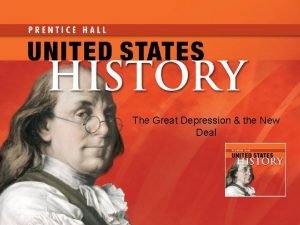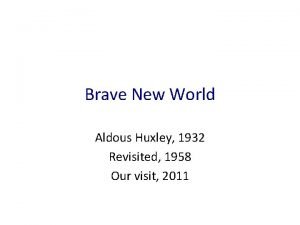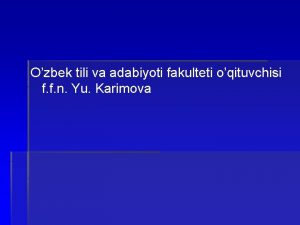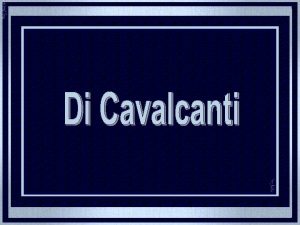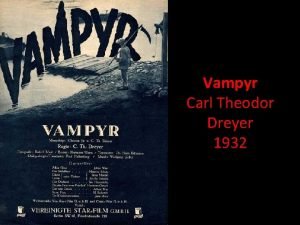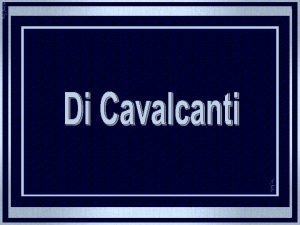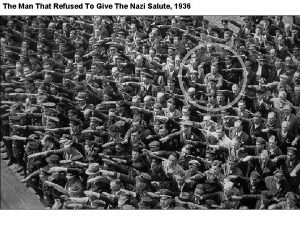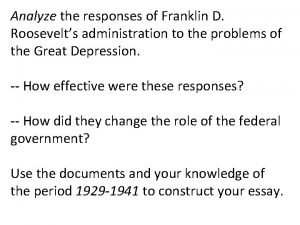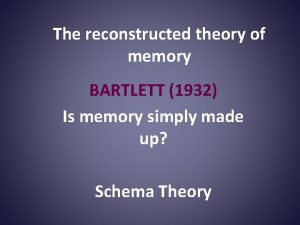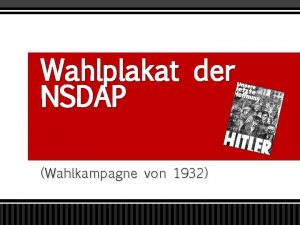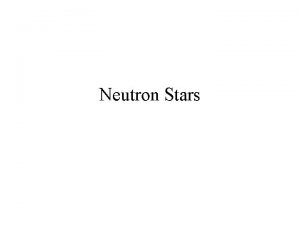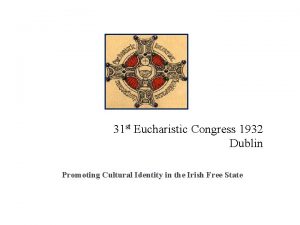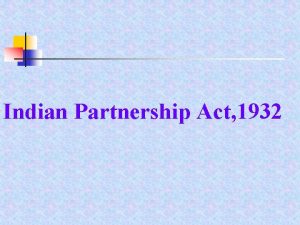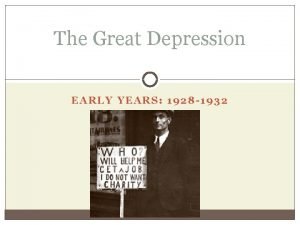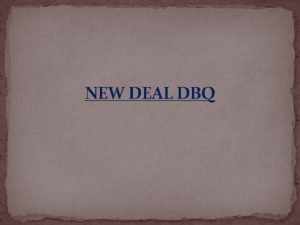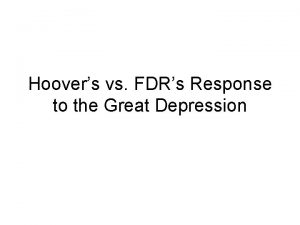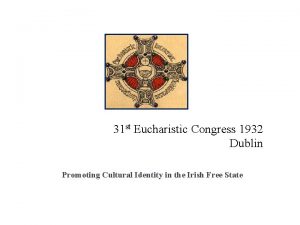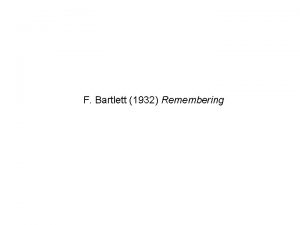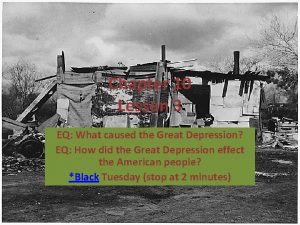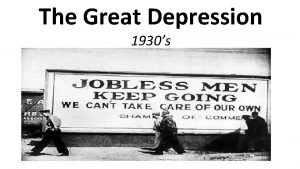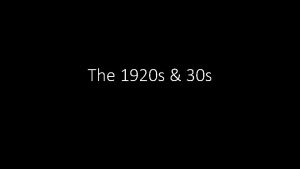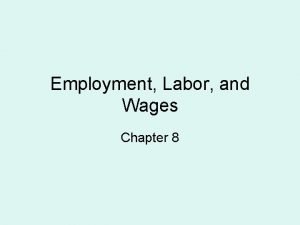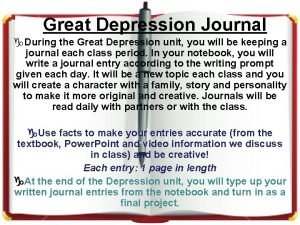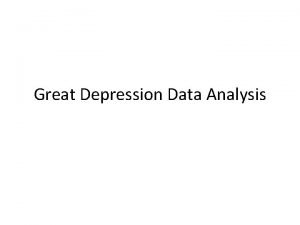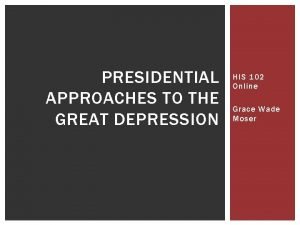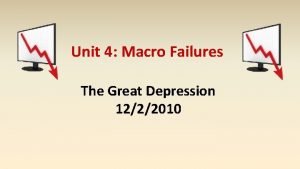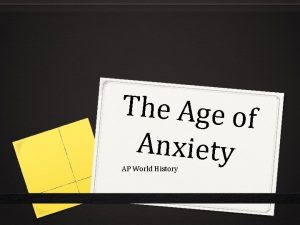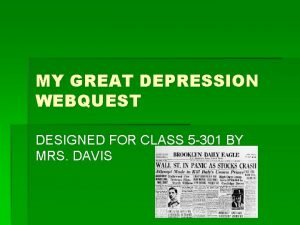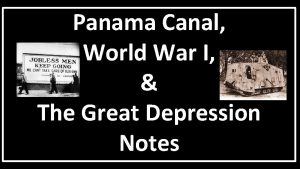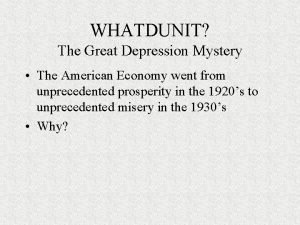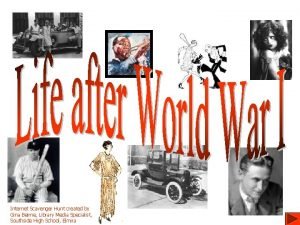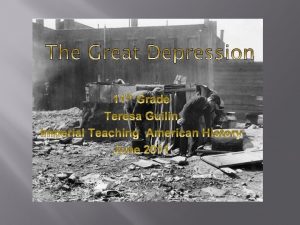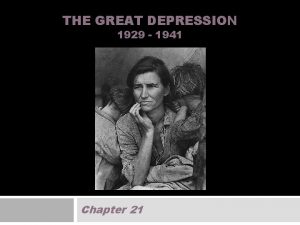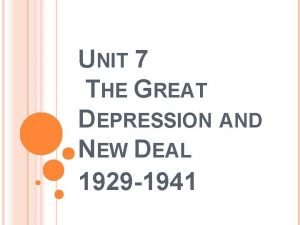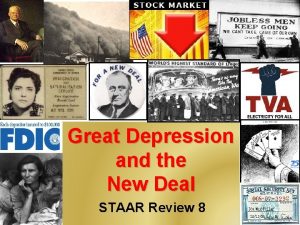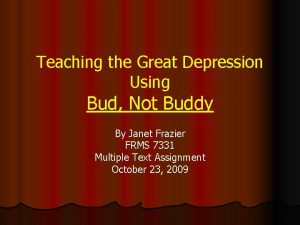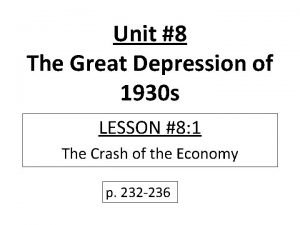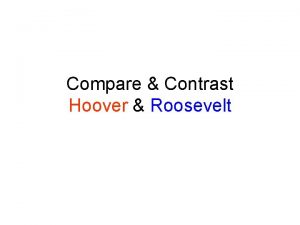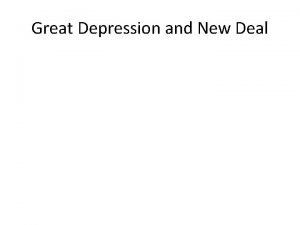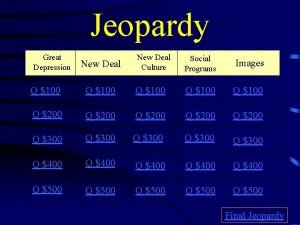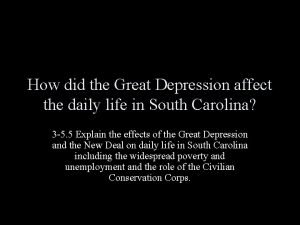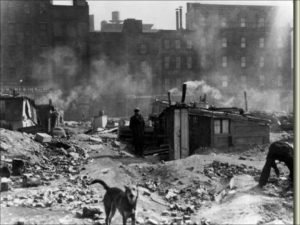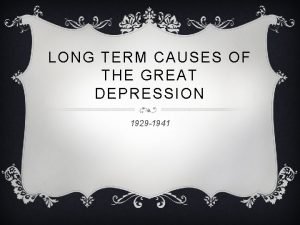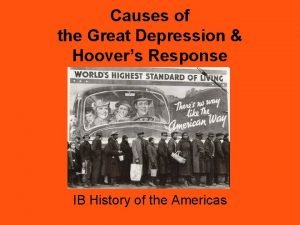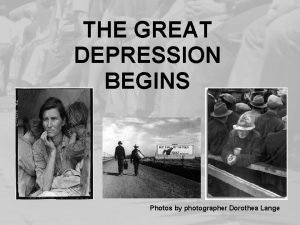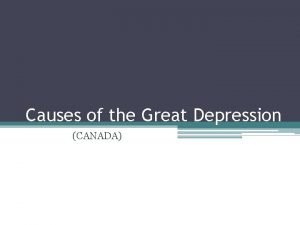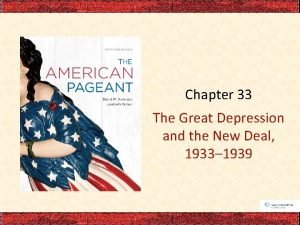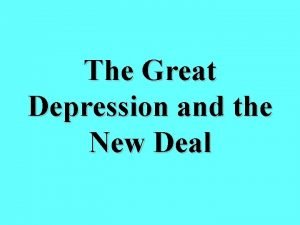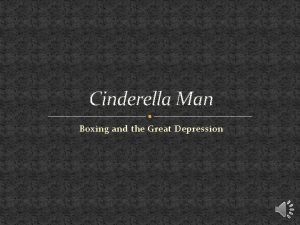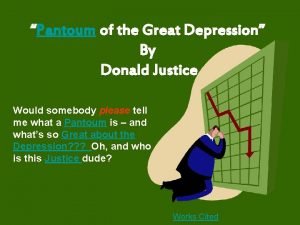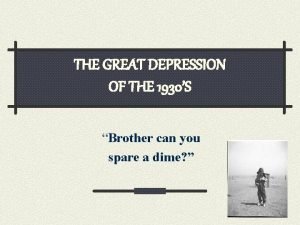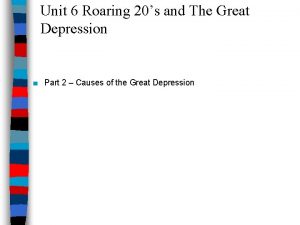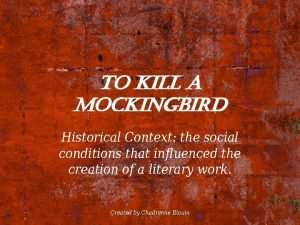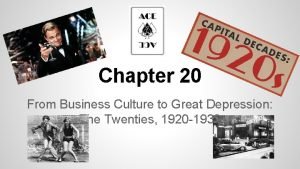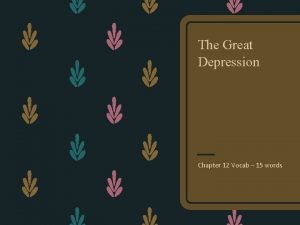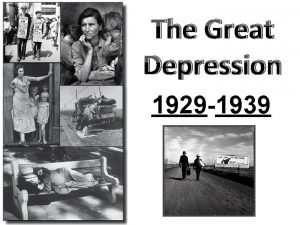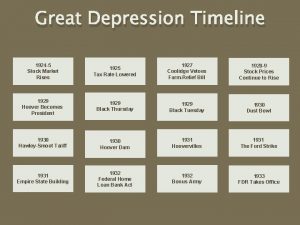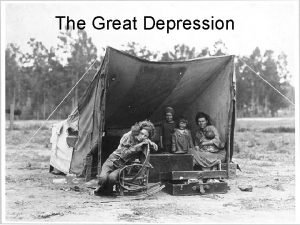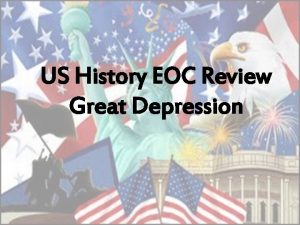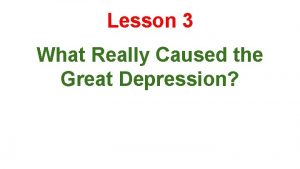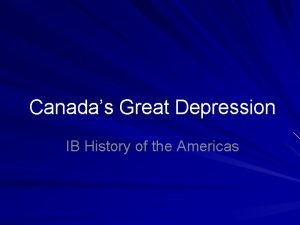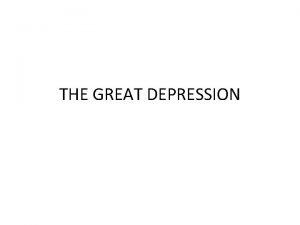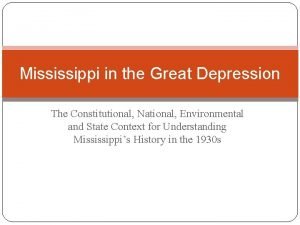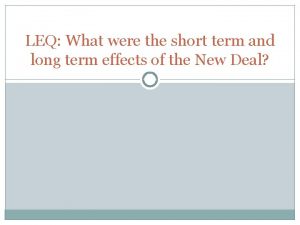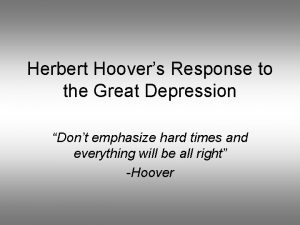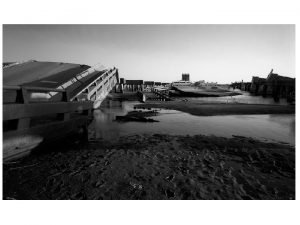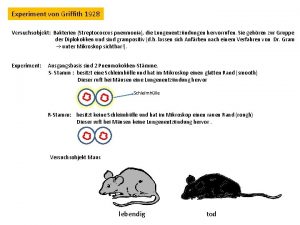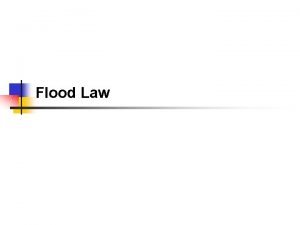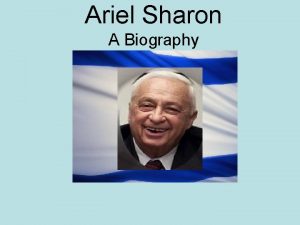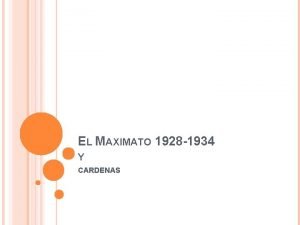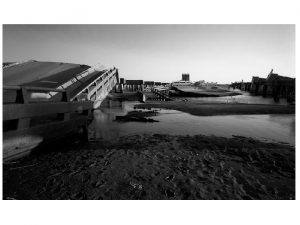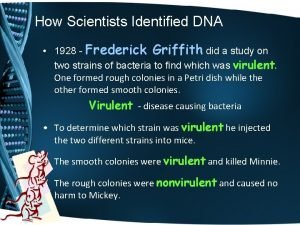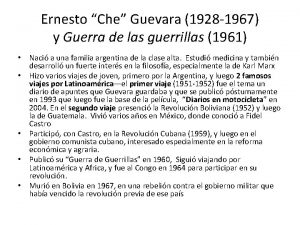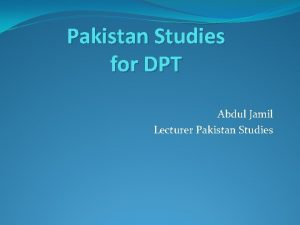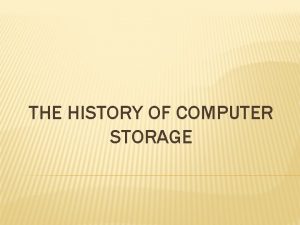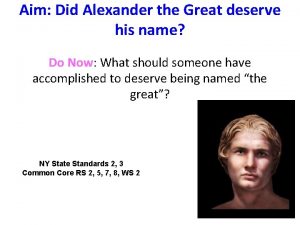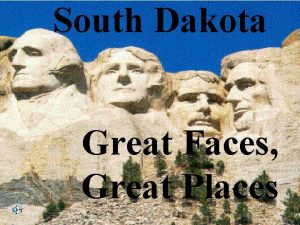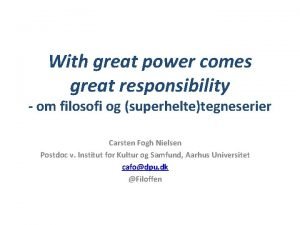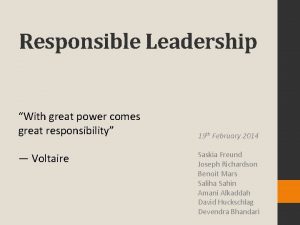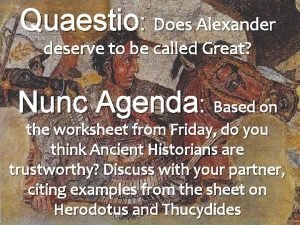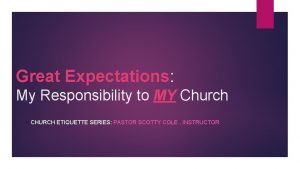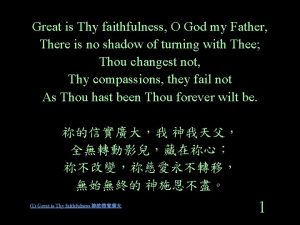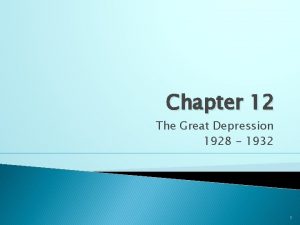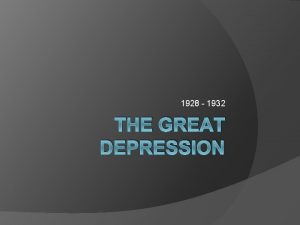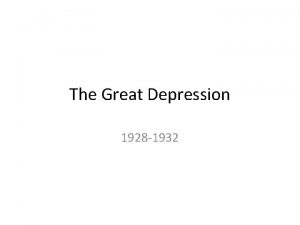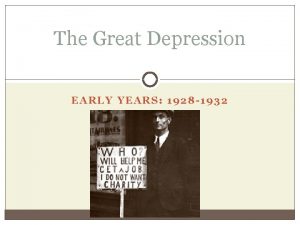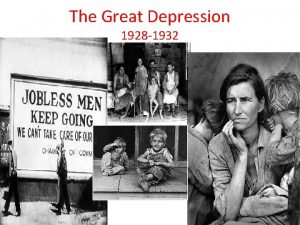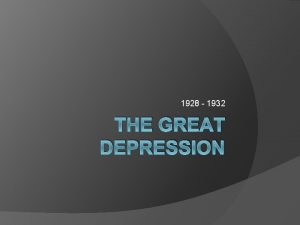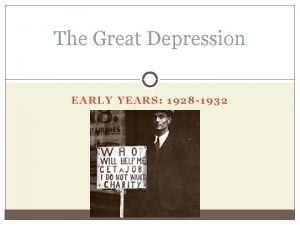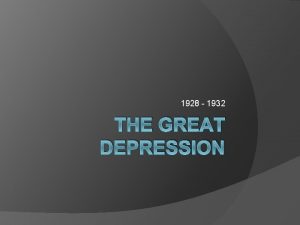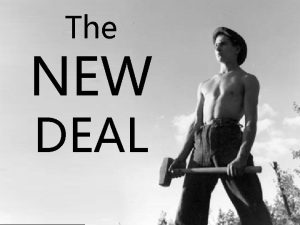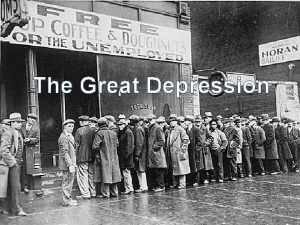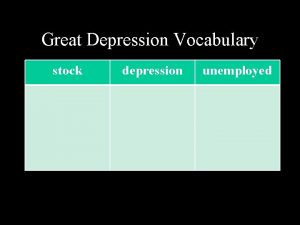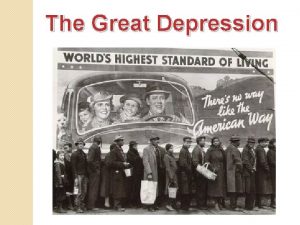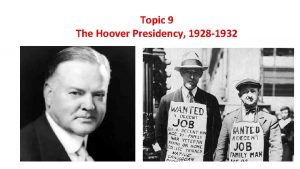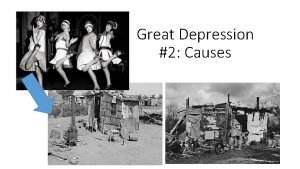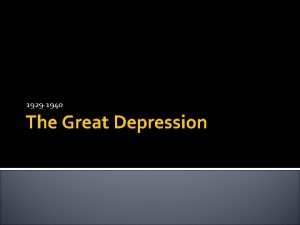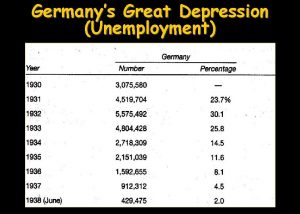The Great Depression 1928 1932 Ch 8 Sec























































































































































- Slides: 151

The Great Depression (1928 -1932) Ch. 8 Sec. 1. Notes # 1 Ø Ø Ø Factors that lead to the Depression - Overproduction of crops and domestic goods, low consumption, wealth disparity, limited money supply, high interest rates, and high stock speculation all contributed to the economic instability and resulted in the Great Depression. Stock speculation - investors engaged in stock speculation because stock prices were soaring, confidence was high, and credit was easy to obtain. Black Tuesday - The stock market collapsed on October 29 th when investors rushed to sell their stocks and prices dropped. Herbert Hoover - was the 31 st President of the United States Prior to becoming president he was known for his humanitarian relief efforts in war-torn Belgium and served as head of the U. S. Food Administration before and during World War I The Great Crash – Continued after October well into November with stock losses totaling $30 billion

The Great Depression (1928 -1932) Ch. 8 Sec. 1. Notes # 1 Farms - The price for crops dropped after World War I and farmers could not sell enough to repay the debt that they had accrued. Ø Scottsboro Case – Nine black youths were accused of rape in Alabama in 1931. The case included a frame-up, an all-white jury, rushed trials, an attempted lynching by angry mobs, and is an example of racism and miscarriage of justice. Ø The Great Depression spread - from the United States to Europe and disrupted international trade and the global economy. Ø Hawley–Smoot Tariff - signed into law on June 17, 1930, that raised U. S. tariffs on over 20, 000 imported goods to record levels. The Smoot-Hawley and the ensuing tariff wars were highly counter-productive at the time. Ø

Class Quiz #1 1. Farmers did not share in the prosperity of the 1920 s because they did not A) try to sell to foreign markets. B) produce enough crops to sell. C) keep up with new technology. D) make enough money to pay off debts. 2. Stock speculation became common because A) many banks had closed. B) stock prices kept going up. C) credit became more difficult to get. D) no confidence in the market. 3. Which economic factors led to the Great Depression? A) underproduction, high consumption, low interest rates, and high stock speculation C) overproduction, disparity of wealth, limited money supply, and high stock speculation D) overproduction, high consumption, limited money supply, and low stock speculation 4. The Great Depression affected A) only American farmers. B) only the United States economy. C) only the United States and European economies. D) the global economy. 5. Which of the following declined sharply on Black Tuesday? A) crop yields B) stock prices C) interest rates D) industrial production

Quick Write #1 In your opinion, what race should a Jury be made up of in order for you to get a fair trial today. Should that be true of all people. Justify your opinion.

The Great Depression (1928 -1932) Ch. 8 Sec. 2. Notes # 2 Ø Ø Ø The Great Depression – urban unemployment increased from under 4 percent in 1929 to almost 25 percent by 1933. Hoovervilles – Many homeless people of the era grouped together and built shanty towns out scrape materials in vacant lots. These became known as Hoovervilles Soup Kitchens and Bread Lines - Many families had to wait in bread lines for handouts and go to soup kitchens for free meals. Dust Bowl - A long drought, severe dust storms, and years of intensive farming that stripped the topsoil from the plains Between 1931 and 1940. So much soil blew out of central and southern great plains that the region became known as the Dust Bowl. Bank Foreclosures – Banks repossessed farm equipment and foreclosed on family farms who failed to pay their mortage. Tenant Farmers – Some framers remained on their land working for bigger land owners rather than themselves.

The Great Depression (1928 -1932) Ch. 8 Sec. 2. Notes # 2 Penny Auction – Farmers would keep bids low on land equipment to assist their neighbors who had lost their farms and equipment to the banks at auction allowing them purchase back their loses for only pennies Ø Okies – Although only some actually came from Oklahoma Dust Bowl refugees became known as Okies. Ø Minority groups - including African Americans and Mexican Americans, were often the last hired and the first fired during the Great Depression when competition for jobs increased Ø Repatriation – Involved efforts by local, state, and federal governments to encourage or coerce Mexican immigrants and their naturalized children to return to Mexico. Ø

Class Quiz #2 1. Hoovervilles referred to what A) increased Unemployment B) Shanty towns C) Foreign Internment camps. D) Stock Market Campers. 2. In the early 1930 s, many families survived by A) eating more meat. B) drinking milk instead of water. C) collecting unemployment compensation. D) getting food from soup kitchens and bread lines. 3. Many homeless people struggled to survive by A) building Hoovervilles. B) avoiding public spaces. C) engaging in stock speculation. D) migrating to the Great Plains to farm.

Ø Ø Ø 4. Which factors contributed to the Dust Bowl? A) drought, dust storms, and intensive farming B) drought, dammed rivers, and intensive farming C) flooding, dammed rivers, and dust storms D) flooding, dust storms, and extensive farming Ø Ø Ø 5. During the Great Depression, minority groups A) migrated south to work on tenant farms. B) often were the last hired and the first fired. C) experienced lower levels of unemployment. D) were deported in large numbers back to their countries of origin.

Quick Write Look at the images on pages 264 -265. What do you think it would have been like to live in hoovervilles.

The Great Depression (1928 -1932) Ch. 8 Sec. 3. Notes # 3 President Hoover's policies - appeared to have failed because despite Hoover's efforts, by the end of his term, employment rates kept rising nearing 25 percent, farm prices were still dropping, and production was slowing. Ø Localism - relied on local and state governments to provide jobs and spearhead relief efforts. Ø The Business Cycle - Hoover thought that the natural business cycle would correct itself. President Hoover followed a hands-off policy at the start of the Great Depression because he viewed the upswings and downswings of business cycles as natural happenings and that business would correct itself. Ø The Reconstruction Finance Corporation – The RFC was established to make loans to banks and business to stimulate economic activity but little of the money trickled down to workers as intended. . Ø

The Great Depression (1928 -1932) Ch. 8 Sec. 3. Notes # 3 Trickle Down Economics – A belief that money poured into the top of the economic pyramid would trickle down to the base. Hoover thought that if the government lent money to bankers then they would lend the money to business, and businesses would hire people. It failed because the banks held the money to pay off the bad loans and the money lent to businesses was distributed to the owners and wasn’t reinvested in hiring new workers. The money stayed at the top. Ø Bonus Army – WW 1 veterans demanded an early payment of A congressional act that promised bonus money to the veterans groups. They argued that the out of work veterans needed the money now. The group of veterans marched on Washington and became known as the Bonus Army. Ø

Quick Write Why do you think in despite of the failing government and economy that Americans were not likely to start a revolution?

Class Quiz Ch. 8 Sec. 3 Ø Ø Ø 1. President Hoover's policies appeared to have failed because A) unemployment rates kept rising. B) production continued to increase. C) prices for farm crops started rising. D) banks took out government loans to stay afloat. Ø Ø 2. What group of people marched on Washington, D. C. after World War I? A) homeless people B) Dust Bowl migrants C) World War I veterans D) Hoover Dam workers Ø Ø Ø 3. Localism emphasized the powers of the A) military. B) Congress. C) President. D) state governments. Ø

Continued Class Quiz Ch. 8 Sec. 3 Ø Ø Ø 4. The RFC most benefited A) banks. B) farmers. C) investors. D) unemployed laborers. Ø 5. President Hoover followed a hands-off policy at the start of the Great Depression because he A) distrusted the idea of "rugged individualism. " B) did not think local and state governments could handle the relief effort. C) viewed the upswings and downswings of business cycles as natural happenings. D) believed that interference by the federal government caused the Great Depression. Ø Ø

The Great Depression (1928 -1932) Ch. 9 Sec. 1. Notes # 4 Ø Ø Ø President Roosevelt - sent his wife Eleanor Roosevelt to inform the Bonus Army that the government could not afford to pay them their bonuses? Localism - Hoover thought that the federal government should stay out of depression relief, leaving it to state and local government. Fireside Chats - President Roosevelt delivered many informal radio messages. These radio messages calmed many Americans' fears about the depression and were known as Fireside Chats Brain Trust - President Roosevelt sought advice from a diverse group of people which offered advice to the President on his New Deal programs nicknamed the F. D. R. – In 1932 Americans were ready for change. The relatively unknown governor of New York Franklin Delano Roosevelt accepted the Democratic Nomination for President. New Deal – A campaign program slogan that promised America change. Roosevelt knew that government had to play a role in recovery and relief to Americans

The Great Depression (1928 -1932) Ch. 9 Sec. 1. Notes # 4 Ø Ø Ø Civilian Conservation Corps (CCC) – A public program that put people to work by maintaining forests, beaches, and parks. FDIC – Federal Deposit Insurance Corporation insured bank deposits up to $5000 dollars (AAA)- Agricultural Adjustment Administration Set up to pay subsides to farmers to stop growing food in the hopes that decreased supply would raise the demand price. Tennessee Valley Authority (TVA) – Provided cheap electricity by re-activating a Hydro-electric plant from WWI. Fire Side chats – Roosevelt communicated to the American people through Informal radio addresses The Federal Council on Negro Affairs – Known as the “Black Cabinet” was led by Mary Mc. Leod Bethune. The Council advised the president and increased support by African Americans for the New Deal

Class Quiz Ch. 9 Sec. 1 Ø Ø Ø Ø 1. established by Congress in 1933 to address a wide range of environmental, economic, and technological issues, including the delivery of low-cost electricity and the management of natural resources? A) AAA B) WPA C) TVA D) CCC 2. Who did President Roosevelt send to inform the Bonus Army that the government could not afford to pay them their bonuses? A) Theodore Roosevelt B) Eleanor Roosevelt C) Charles Coughlin D) Herbert Hoover 3. Herbert Hoover believed that depression relief should come from the A) armed forces. B) southern farmers. C) federal government. D) state and local government.

Class Quiz Ch. 9 Sec. 1 continued Ø Ø Ø Ø Ø 4. President Roosevelt delivered many informal radio messages called A) radio announcements. B) radio chats. C) fireside chats. D) presidential discussions. 5. President Roosevelt sought advice from a diverse group of people nicknamed the A) Brain Trust. B) eyes and ears. C) New Deal Coalition. D) Bonus Army.

Quick Write President Roosevelt sought advice from a diverse group called his Brain Trust If President Obama hired you as part of his brain trust what would you advise him to do? Video: http: //www. youtube. com/watch? feature=player_detailpage&v=6 b Mq 9 Ek 6 jn. A

The Great Depression (1928 -1932) Ch. 9 Sec. 2 Notes # 5 Ø Ø Ø 2 nd New Deal – The second one hundred days of FDR’s presidency where he introduced social welfare benefits, stricter control over business, stronger support for unions, and higher taxes on the rich. Social Security System – Provided financial security to people who could not support themselves. This included old age pensions and survivors benefits, unemployment insurance, and aid for children and the disabled. African Americans - were disproportionately employed as domestic workers and farmworkers and therefore were not eligible for Social Security benefits. The Rural Electrification Act provided - money to electric utilities to build power lines. Public Work Programs (PWP) – Government funded projects to build facilities, and to put people to work

The Great Depression (1928 -1932) Ch. 9 Sec. 2 Notes # 5 Ø Ø Ø Supreme Court - declared the NIRA (National Industrial Recovery Act) unconstitutional and refused to the funding for Farm subsides under the (AAA) Agricultural Adjustment Administration FDR's "court packing" plan - When the Supreme Court began voting against the constitutionality of New Deal programs, FDR wanted to add justices to the court to lessen the power of more conservative justices. Wagner Act –Recognized the rights of workers to join labor unions and gave them right to use collective bargaining. Collective bargaining – Meant that employers had to negotiate with the Unions about hours, wages, work conditions Fair Labor Standards Act – Provided workers with more rights such as minimum wage, a maximum work week of 44 hours, and outlawed child labor.

Class Quiz Ch. 9 Sec. 2 Ø Ø Ø 1. The Social Security Act provided benefits for A) farmers. B) artists. C) retirees. D) domestic workers. Ø Ø Ø 2. The Rural Electrification Act provided A) telephones to all farmers and farmworkers. B) incentives for industry to move to rural areas. C) money to electric utilities to build power lines. D) land for farmers to build hydroelectric plants. Ø 3. FDR's "court packing" plan was designed to help lessen the power of which group? A) farmers B) the Cabinet C) Supreme Court D) labor unions Ø Ø

Ø Ø Ø 4. Which of the following groups was most often denied Social Security benefits because of their type of employment? A) blue collar workers B) government employees C) elderly women D) African Americans

Quick Write: Social Security System was designed as a safety net for those Americans who could not support themselves. This system may not be available to you when you retire because government has used it unwisely. However, you will pay into it through your taxes most of your adult life. How does that make you feel?

The Great Depression (1928 -1932) Ch. 9 Sec. 3 Notes # 6 Ø Ø Ø The Role of First Lady - Eleanor Roosevelt refused to be only a ceremonial role as First Lady. First Ladies did not traditionally speak out concerning political issues. Eleanor expressed her opinion openly by her "My Day" column entries The negative effect of the TVA - The building of dams and other projects along the Columbia River upset the natural habitat of aquatic life in the area. The effect on Congress - The New Deal Coalition gave the Democrats a majority in Congress. Democrats controlled the House of Representatives for all but four years from 1932 to 1995. Automatic pay deductions - To give money to the elderly, the federal government began withdrawing money directly from paychecks. This was the first time that the government had withdrawn money directly from paychecks. The Effect on immigrants - felt a greater sense of belonging to the mainstream because of programs like the WPA and CCC. These programs put people from different backgrounds together, which often broke down regional and ethnic prejudices

The Great Depression (1928 -1932) Ch. 9 Sec. 3 Notes # 6 Ø Ø Ø New Deal Critics - Claim the New Deal is Un-American and that it leading to Socialism and/or a communist style state. Economic Nationalism – A government takeover of banks and other institutions. The banks were now regulated by the federal government and insured. Many feared total takeover and a socialist state Socialism - an economy in which the state owns the major factors of production, central planning occurs, and attempts are made to equalize income American Liberty League – A group led by Presidential candidate Alfred E. Smith called the New Deal unconstitutional and un-American Demagogues – Leaders who manipulate people with half truths, deceptive promises, and scare tactics Deficit spending – paying out more money from the annual federal budget than the government receives from revenue

Class Quiz Ch. 9 Sec. 3 Ø Ø Ø Ø 1. What group felt a greater sense of belonging to the mainstream because of programs like the WPA and CCC? A) Native Americans B) immigrants C) women D) farmers 2. The New Deal Coalition gave which political group a majority in Congress? A) Democrats B) Republicans C) Independents D) Socialists 3. Which characteristic of Eleanor Roosevelt is shown by her "My Day" column entries? A) concern for equality in the national government B) distrust of all elected members of Congress C) enjoyment in pointing out the flaws of Congress D) refusal to lead only a ceremonial role as First Lady

Class Quiz Ch. 9 Sec. 3 Ø Ø Ø Ø Ø 4. What negative effect did the TVA and the dams built along the Columbia River have on the environment? A) damaged habitats B) caused flooding C) sped up soil erosion D) caused the Dust Bowl 5. To give money to the elderly, the federal government began A) increasing the poll tax B) placing tariffs on goods C) withdrawing money directly from paychecks D) spending money it did not have

Quick Write: Alaska has huge deposits of oil. Do you believe that we should drill for the oil in the Alaskan wilderness and possibly upset the environment?

The Great Depression (1928 -1932) Ch. 9 Sec. 4 Notes # 7 Ø Ø Ø Federal Art Project - funding to popular and fine arts programs created a boom in culture. Literature – Several classics emerged during this time like “The Good Earth” by Pearl Buck and the “The Grapes of Wrath” by John Steinbeck. Radio and Movies – these new mediums provide an escape from everyday life. Radio host like Jack Benny and George Burns were popular. Movies by the Marx Bothers and the provided laughter and amazement. The Wizard Oz – One of the most memorable depression-era films. In it Dorothy sings of better times in “Somewhere over the rainbow” Snow White and the Seven Dwarfs - produced by Walt Disney in 1937. It is the first full-length cell animated feature film Superman - is a fictional character, a superhero that appears in comic books and is an American cultural icon first appeared in Action Comics in June 1938.

The Great Depression (1928 -1932) Ch. 9 Sec. 4 Notes # 7 The War of the Worlds – Based on the book by H. G Wells, the Mercury Theatre directed by Orson Welles aired a Halloween Radio broadcast on October 30, 1938, which suggested to many listeners that an actual alien invasion by Martians was currently in progress. Ø Frank Capra - one of America's most influential directors during the 1930’s Great Depression years, when audiences needed uplifting themes of inspiration. His movies include Mr. Smith Goes to Washington (1939) and It's a Wonderful Life (1946) Ø The Resettlement and Farm Security Administration wanted people to know what it's like to live on a farm, so they hired photographers to document farm life. Ø Dorothea Lange - was an influential American documentary photographer and photojournalist, best known for her Depression-era work for the Farm Security Administration (FSA) Ø

Class Quiz Ch. 9 Sec. 4 1. The fact that in the 1930 s two in three homes owned a radio shows A) movies' decline. B) The Shadow's believability. C) radio's popularity. D) the country's wealth. 2. The FSA hired photographers to document the life of what group? A) immigrants B) farmers C) children D) women 3. Many writers during the Great Depression featured A) wealthy politicians. B) working-class heroes. C) gangsters and criminals. D) artists and musicians.

Class Quiz Ch. 9 Sec. 4 4. Which writer wrote a book about the farmers who fled the Dust Bowl states to head west A) John Steinbeck B) Richard Wright C) Woody Guthrie D) Glenn Miller 5. The idea that Americans went to the movies to find some relief from their troubles was to A) recovery from the Depression B) triumph over the banks C) Worsen their income by spend money on useless things D) escape the problems and worries of the depression.

Quick Write: When you need to escape from your problems what music/book/movie would you choose?

The Coming War (1931 -1942) Ch. 10 Sec. 2 Notes # 8 Ø Ø Ø Ø Nazi-Soviet Nonaggression Pact in 1939 - Germany and Russia agreed to share Poland on the condition that neither would move aggressively against the other, even though they were on opposing sides during World War II Blitzkrieg of Poland - Germany's invasion of Poland represented a relatively new style of warfare that quickly overwhelmed the target of attack. The invasion of Poland begins WW 2 in Europe Isolationism – a policy that ignored international affairs and focused on domestic issues. Neutrality Acts – A series of acts designed to keep America out the war. America First Committee – A group of Americans that felt supplying aide to Britain was just one step away from war with Germany Cash-and-Carry – The neutrality acts permitted trade with nations that paid cash and transported the goods themselves Lend-Lease Act – Authorized the President to aid any nation whose defense he believed was vital to American Security

The Coming War (1931 -1942) Ch. 10 Sec. 2 Notes # 8 The Atlantic Charter - policy statement issued in August 1941 that set goals for the post-war world. It was drafted by the leaders of Britain and the United States, and later agreed to by all the Allies Ø The Atlantic before war - When Germany attacked three U. S. ships escorting shipments of arms to Iceland, the United States President Roosevelt ordered U. S. ships to shoot German U-boats on sight and moved the United States closer to war. Ø Radio – The mass media brought live reports of the war in Europe into the homes and lives of Americans, and provided radio coverage of the situation in London. Ø

Class Quiz Ch. 10 Sec. 2 1. Germany's blitzkrieg of Poland involved A) invasion from three directions. B) air assaults. C) infantry assaults. D) all of the above 2. Which form of mass media brought live reports of the war in Europe into the homes and lives of Americans? A) newspaper B) newsreel C) radio D) telegraph 3. When Germany attacked three U. S. ships escorting shipments of arms to Iceland, the United States A) complained to the League of Nations. B) privately condemned the attack. C) practiced restraint. D) issued orders to shoot German U-boats on sight.

Class Quiz Ch. 10 Sec. 2 4. policy that ignored international affairs and focused on domestic issues. A) Atlantic Charter B) Isolationism C) America First D) Lend-Lease Act 5. A policy statement issued in August 1941 that set goals for the post-war world. A) Atlantic Charter B) Isolationism C) America First D) Lend-Lease Act

Quick Write: Without a declaration of war from Congress FDR ordered the shoot on sight command towards any NAZI submarine. Do you feel that his actions were correct or that he should have first got authorization from Congress according to the constitution?

The Coming War (1931 -1942) Ch. 10 Sec. 3 Notes # 9 Ø Ø Ø U. S. objects – When Japan demanded access to natural resources in the Dutch East Indies The United States objected and threatened to impose economic sanctions and steel embargo to the Japanese island. Hideki Tojo – The Japanese prime minister decided that a decisive strike against the U. S. in the Pacific was Japan’s best option. Japanese Code - Americans technicians had broken the Japanese secret code in 1940, although they knew Japan was in the Pacific and going to attack, they did not know where. Pearl Harbor - Shortly after 8 am on Sunday December 7, 1941, over 180 Japanese war planes streaked overhead Pearl Harbor and bombed and strafed the fleet and nearby airfield. The attack was over by 9: 45 A day that will live in infamy - The day after the attack on Pearl Harbor, President Roosevelt asked congress to declare war on Japan

The Coming War (1931 -1942) Ch. 10 Sec. 3 Notes # 9 Ø Ø Ø War ends the Depression – While the war brought some shortage and rationing it did end the depression by sending people of to work for the war production. Factories like Ford started to produce tanks on their assembly lines. Rosie the Riveter – Women in the work place were symbolized by the this female character riveting aircraft together in factories. Battle of the Coral Sea – a battle of aircraft carriers where the Japanese advance across the pacific was finally stopped and it prevented the possible invasion of New Guinea and Austrlia. The Doolittle Raid - was an air raid by the United States on the Japanese capital Tokyo. It demonstrated that Japan itself was vulnerable to American air attack Bataan Death march - a 6– 10 day 6 o mile March of American Prisoners through the Philippines tropical heat without water or food. 10, 000 prisons died on the march and another 15, 000 died in the prison camp

The Coming War (1931 -1942) Ch. 10 Sec. 3 Notes # 9 Ø Battle Of Midway – The turning point in the Pacific. America caught the Japanese fleet by breaking their code and discovering which island they planned on attacking. In the largest naval battle of WWII, American and Japanese aircraft carriers engaged each other. 4 Japanese Carriers were lost and one American Carrier.

Class Quiz Ch. 10 Sec. 3 Ø Ø Ø Ø 1. Women in the work place were symbolized by the this female character in factories? A) Martha the economic recovery Girl B) Rosie the Riveter. C) Josie the Factory Girl. D) Eleanor Roosevelt. 2. President Roosevelt referred to this event as “A day that will live in infamy”. A) be excused from service in the armed forces. B) The Holocaust in Europe. C)Germany’s bombing of London. D)The Japanese attack on Pearl Harbor. 3. What event demonstrated that Japan itself was vulnerable to American air attack? A) the Battle of Coral Sea B) the Battle of Midway C) the Bataan Death March D) The Doolittle Raid

Class Quiz Ch. 10 Sec. 3 Ø Ø Ø Ø Ø 4. As a result of the Battle of Coral Sea, U. S. forces successfully A) captured Japan's largest aircraft carrier. B) regained control of the Philippines. C) prevented Japan from invading New Guinea. D) sunk two ships in Japan's fleet of ships. 5. What tropical island were American Prisoner forced a 6– 10 day 6 o mile Bataan Death march? A) Philippines B) New Guinea C) Hawaii D) Australia

Play video: Days That Changed History Pearl Harbor Question:

The Coming War (1931 -1942) Ch. 11 Sec. 1 Notes # 10 Ø Ø Ø The Eastern Front – Hitler decided that The Soviets must be taken to end the war. the attack began June 22, 1941. Hitler was convinced that the Soviets could be defeated before winter. Stalin requested assistance from the Allies. The U. S. along with Britain agrees to pursue a Europe First strategy plan focusing on the defeat of Hitler. Stalin – requested that England open a second front in the west against Germany to pull German troops away from Russia Stalingrad –The German forces began the battle to take the city and it lasted 2 and half years. Over a million soviets died in the siege, but the city never fell to the Germans and Finally, the German army is surrounded and forced to retreat in June 1943. Unconditional Surrender – the Allies agree that they will except nothing less than an unconditional surrender by Germany. Dwight D. Eisenhower – American General in command of the Allied forces in Africa and pushed across Africa trapping Rommel and forcing the surrender in may 1943

The Coming War (1931 -1942) Ch. 11 Sec. 1 Notes # 10 Ø Ø Ø George S. Patton – Given command of American forces in North Africa by Eisenhower. Italy – American and British forces land in Sicily and pave the way to invading Italy. On September 3, 1943 Italy surrenders to the Allies and five weeks later declares war on Germany. Carpet Bombing – Scattering a large number of bombs over a wide area in order to inflict maximum damage. Strategic Bombing – targeting specific locations, installation, railways, and factories to destroy Germany’s war making capacity. Tuskegee Airmen – An African American fighter squadron played a key role in protecting bombers from enemy fighter pilots. In more than 1500 missions they did not lose a single bomber.

Class Quiz Ch. 11 Sec. 1 1. protected bombers from enemy fighter pilots in Europe? A) George S. Patton B) Dwight Eisenhower C) The Flying Tiger Squadron D) Tuskegee Airmen Squadron 2. The Allied strategy for World War II called for first gaining victory in A) Europe. B) the Pacific. C) Japan. D) North Africa. 3. How did the Soviet Union become an ally to England The United States? A) Stalin realized that Hitler was not a good person B) Japan attacked the Soviet Union and broke the non aggression pact with Germany C) Hitler attacked the Soviet Union and broke the non aggression pact D) The U. S. convinced Stalin to break the non aggression pact with Germany.

Class Quiz Ch. 11 Sec. 1 4. Which of the following was a result of the battle at Stalingrad? A) Hitler's forces gained control of the Caucasus oil fields. B) Germany was forced to capture Moscow. C) Nazi armies were forced to retreat in June 1943. D) The German army continued its march toward Leningrad. 5. The 1943 Allied invasion of Sicily A) led to Tojo's capture and death. B) ended all fighting in Italy during the war. C) protected Allied forces from further German U-boats attacks. D) gave the Allies complete control of the western Mediterranean.

Quick Write: “The Enemy of my Enemy is my Friend” How does this apply to the Soviet Union in WW 2. Do you agree with this quote?

The Coming War (1931 -1942) Ch. 11 Sec. 2 Notes # 11 Ø Ø Ø During World War II - the U. S. national debt skyrocketed. In six years' time around World War II, the U. S. national debt climbed from $42 billion to $269 billion. American Propaganda – To remind Americans that they were engaged in a struggle for freedom the government used posters to remind Americans that they were fighting to defeat fascism and protect democracy by connecting the goals of World War II with those of the American Revolution World War II - accelerated long-term trends toward female employment. Although women were expected to give up the jobs they had held in blue-collar settings, long-term trends toward female employment in white-collar settings accelerated because of the war. Executive Order 8802 - established the Fair Employment Practices Committee to enforce fair hiring practices in any job funded with government money. A committee was set up to enforce fair hiring practices in government-funded jobs. Korematsu v. United States - In the case, the United States Supreme Court decided that the government had the right to intern citizens and aliens in wartime for the purpose of national security during wartime

The Coming War (1931 -1942) Ch. 11 Sec. 2 Notes # 11 Japanese American internment – shortly after Imperial Japan's attack on Pearl Harbor, The U. S. government ordered an internment in 1942, to "War Relocation Camps" of over 110, 000 people of Japanese heritage who lived on the Pacific coast of the United States Ø The 442 nd Regimental Combat Team – in the United States Army was a regimental size fighting unit composed almost entirely of American soldiers of Japanese descent who fought in World War II, despite the fact many of their families were subject to internment. The 442 nd is considered to be the most decorated infantry regiment in the history of the United States Army. Ø The United States Office of War Information (OWI) - was a United States government agency created during World War II to consolidate existing government information services and deliver propaganda both at home and abroad through radio broadcasts, newspapers, posters, photographs, films and other forms of media Ø

Class Quiz Ch. 11 Sec. 2 1. Which of the following resulted from the passage of Executive Order 8802? A) The Congress of Racial Equity was established. B) The military ended segregation in its various military divisions. C) African Americans led a large protest march on Washington, D. C. D) A committee was set up to enforce fair hiring practices in government-funded jobs. 2. World War II accelerated long-term trends toward female employment in A) war production. B) blue-collar settings. C) white-collar settings. D) day-care centers. 3. In the case of Korematsu v. United States, the United States Supreme Court decided that A) states were required to house internment camps. B) states could not force citizens to give up their property. C) the government could intern citizens and aliens in wartime. D) Japanese Americans could not serve in the U. S. military.

Class Quiz Ch. 11 Sec. 2 4. What was the purpose of posters comparing the American Revolution and World War II? A) remind Americans that they were engaged in a struggle for freedom B) encourage Americans to ration goods and purchase war bonds C) maximize poverty and crime problems in the United States D) minimize U. S. racial and economic divisions 5. During World War II, A) the U. S. national debt skyrocketed. B) the government lowered taxes. C) prices of goods fell rapidly and inflation soared. D) increased production led to a surplus of consumer goods

Quick Write: Do you think it would have been right to intern all Muslims after the 9/11 attacks on the World trade buildings? Compare that to the Japanese internment after Pearl harbor.

Mid-Way Video: http: //www. youtube. com/wat ch? feature=player_detailpage &v=r 3 Ff. FDukdp. I

The Coming War (1931 -1942) Ch. 11 Sec. 3 Notes # 12 D-Day - The Normandy landings, codenamed Operation Neptune, were the landing operations of the Allied invasion of Normandy, in Operation Overlord, during World War II. The landings commenced on Tuesday, 6 June 1944 (D-Day). the term D-Day was used for the day of the actual landing. on D-Day The Allied forces encounter strong resistance opposition on Omaha beach. Ø Prior to the D-Day invasion - the Allies gathered the largest fleet ever assembled. The Allied fleet consisted of 4, 400 ships and landing crafts, making it the largest fleet ever assembled. Ø V-E Day – Victory in Europe. By early 1945, Allied forces were approaching Berlin from several different directions. On May 7, 1945, Germany surrendered as Allied forces began to surround Berlin. Ø

The Coming War (1931 -1942) Ch. 11 Sec. 3 Notes # 12 General Douglas Mac. Arthur - led United States Marines in the summer of 1942 as the United States began a campaign to gradually move American forces toward the mainland of Japan? Ø Island hoping – A policy of by-passing Japanese controlled islands for more strategic targets and choking off supplies to those islands which were skipped. Ø Okinawa - was the location of the most costly and complex operation in the Pacific campaign. Taking Okinawa was the most complex and costly operation in the Pacific campaign, as it involved 500, 000 troops and 1, 213 warships. The battle cost U. S. forces approximately 50, 000 casualties Ø Kamikaze pilots - Kamikaze pilots agreed to suicide missions in which they crashed their explosive-laden airplanes into American warships. Ø

The Coming War (1931 -1942) Ch. 11 Sec. 3 Notes # 12 Admiral Chester Nimitz - commanded the United States Navy in 1944, successfully blockading Japanese ports in 1944 as American bombers pounded Japanese cities and industries. Ø The Yalta Conference - Franklin Delano Roosevelt, Winston Churchill, and Joseph Stalin agreed to the following terms. 1 The Soviet Union would enter the war against Japan within three months of Germany's surrender. 2 - Churchill and Roosevelt promised Stalin that the Soviets could take control of southern Sakhalin Island, the Kuril Islands, and an occupation zone in Korea. 3 - They also agreed that Germany would be temporarily divided into four zones to be governed by American, French, British, and Soviet forces. Ø The Manhattan Project - Allied scientists conducted research, code-named the Manhattan Project, in a race with the Germans to harness the atom. In July of 1945, they successfully tested the first atom bomb at Alamogordo, New Mexico. Ø

The Coming War (1931 -1942) Ch. 11 Sec. 3 Notes # 12 The Bomb – Two different bomb were created “Fat Boy” and “Thin Man”. The first atomic bomb was dropped on the Japanese city of Hiroshima on August 6, 1945. Japanese city was the target of the second atomic bomb, dropped by the United States on August 9, 1945? Ø The Japanese surrendered – two days after the United States dropped a second atomic bomb on the city of Nagasaki Ø Ø Ø War Dept. (12 min) http: //www. youtube. com/watch? feature=player_detailpa ge&v=d 3 o. SS_FP-c. A Ø 50 years later (60 min) Ø http: //www. youtube. com/watch? feature=player_detailpage&v=9 Wn. LNLe 3 sk

QUICK WRITE: "The world will note that the first atomic bomb was dropped on Hiroshima, a military base. That was because we wished in this first attack to avoid, insofar as possible, the killing of civilians. But that attack is only a warning of things to come. If Japan does not surrender, bombs will have to be dropped on her war industries and, unfortunately, thousands of civilian lives will be lost. I urge Japanese civilians to leave industrial cities immediately, and save themselves from destruction. “ — President Truman in a radio speech August 9, 1945. According to the above quotation, why did the United States choose Hiroshima as the target for the dropping of the first atomic bomb? What would you have done?

Class Quiz Ch. 11 Sec. 3 1. Who commanded the United States Navy in 1944, successfully blockading Japanese ports? A) Admiral Chester Nimitz B) Admiral Ernest King C) Admiral William Halsey, Jr. D) Admiral William Leahy 2. Kamikaze pilots A) were sent only on the most dangerous missions. B) rebelled against Japanese rule, joining the Allies in late 1944. C) helped the Nazis during their assault on the British islands. D) crashed their explosive-laden airplanes into American warships. 3. American forces embarked on a campaign known as _____, with the goal of recapturing some Japaneseheld islands which were used as steppingstones to the next objective. A) the Pacific theatre B) island-hopping C) Operation Free Asia D) the Tokyo Plan

Class Quiz Ch. 11 Sec. 3 4. The Manhattan Project was A)a plan to save New York City from a potential German invasion. B) the name for the overall plan used to eventually defeat the Nazis. C) a project conducted by Allied scientists in an effort to create an atomic bomb. D) a secret spy ring that provided Allied intelligence useful information about enemy activities 5. May 8, 1945, the day after Germany surrendered, officially became known as A) V-E Day. B) Memorial Day. C) V-J Day. D) Veterans Day

The Coming War (1931 -1942) Ch. 11 Sec. 4 Notes # 13 Hitler - blamed German Jews for creating all of Germany's economic, political, and social troubles. Hitler, along with other members of the Weimar Republic in the 1920 s, preached hatred of Jews as a simplistic answer to Germany's grave issues Ø Kristallnacht German -"Night of the Broken Glass, " took place on November 9, 1938. During this attack, German secret police and military units destroyed more than 200 synagogues and 7, 500 Jewish businesses; many Jews were injured and killed. Ø The Nuremberg Laws - established a legal basis for complete discrimination against Jews by denying them German citizenship, forbidding marriage between Jews and non-Jews, and segregating Jews at every level of society. Ø Nazi concentration camps - The Nazis imprisoned many groups including political opponents, socialists, communists, and labor leaders. Some 5, 000 mentally and physically disabled children died in the camps. Ø

The Coming War (1931 -1942) Ch. 11 Sec. 4 Notes # 13 The Final Solution – Hitler’s answer to what he called the Jewish problem. The construction of death camps built in Poland designed for the sole purpose of exterminating the Jews. German engineers designed the most efficient means to killing millions of men, women, and children. Ø Holocaust - While the Nazis killed approximately 12 million people during the Holocaust, 6 million of them were Jews aprox. ¾ of the Population Jewish population in Europe. Jews to be confined in overcrowded ghettos before being transported by freight train to extermination camps where, if they survived the journey, most were systematically killed in gas chambers Ø Genocide – The deliberate mass murder of an entire ethic population Hitler pursued a vicious program to kill all people he judged “racially inferior”, especially European Jews Ø

The Coming War (1931 -1942) Ch. 11 Sec. 4 Notes # 13 War Refugee Board - created to aid civilian victims of the Nazi and Axis. The board developed and implemented various plans and programs for Rescuing, transporting, and relieving victims of enemy oppression and Establishing of havens of temporary refuge for such victims Ø American Response – After the liberation of Nazi concentration camps caused an outpouring of American sympathy. The liberation of the camps allowed most Americans to realize the enormity of the Nazi crime and led to a sincere longing on the part of Americans to help the victims. It increased demand for a Jewish home State in the community of Palestine. Ø

Class Quiz Ch. 11 Sec. 4 1. The liberation of Nazi concentration camps A) caused an outpouring of American sympathy. B) led to the creation of the War Refugee Board. C) preceded the D-Day invasion of Normandy. D) provoked the bombing of German railway lines. 2. Which of the following groups was put into Nazi concentration camps? A) doctors B) soldiers C) mentally ill D) scientists 3. The Nuremberg Laws compelled Jews to perform low-level jobs in civil service. urged Germans to boycott Jewish-owned businesses. ordered notable Jewish figures to leave Germany. established a legal basis for discrimination against Jews.

Class Quiz Ch. 11 Sec. 4 4. What happened during Kristallnacht? A) Many Jews were taken to concentration camps. B) Hitler proposed his "final solution to the Jewish question. " C) Nazi’s destroyed synagogues and Jewish businesses. D) Many Jews fled Germany for refuge in the United States. 5. Hitler blamed German Jews for A) providing simplistic answers to serious problems. B) Germany's economic, political, and social troubles. C) creating vile caricatures of famous German politicians. D) destroying businesses and homes on Kristallnacht.

The Coming War (1931 -1942) Ch. 11 Sec. 5 Notes # 14 Ø Ø Ø The New American identity - arose from the ashes of World War II and was formed as the antithesis of the Nazi ideal. The A new American identity that arose following World War II regarded Americans as democratic, tolerant, and peaceful. Britain Affected - After World War II, the British Empire faced economic shortages and eventually the loss of most of its colonies. Post World War II Americaa - World War II helped end the Great Depression and redistribute wealth across the United States. Nuremberg Trials - The Allies put on trial Axis leaders in Nuremberg, Germany for "crimes against humanity. A total of 177 Germans and Austrians were tried, and 142 were found guilty of "crimes against humanity“ Yalta –Following the Yalta Conference, Stalin reneged on his promises that Poland, Romania, and Bulgaria would become independent countries and hold free elections.

The Coming War (1931 -1942) Ch. 11 Sec. 5 Notes # 14 The German Division – The Allied powers divided Germany into four zones each controlled by one of the allies (USA, Soviet Union, England, and France). The capital City Berlin was also divided into four zones and controlled by each of the allies. Ø United Nations (U. N. ) - An international peace keeping organization. All member nations belong to the general assembly and 11 representatives serve on the Security Council. The five permanent members of the UN Security Council are the United States, Russia, France, Great Britain, and China. Ø The General Agreement on Tariffs and Trade (GATT) was a multilateral agreement regulating international trade. According to its preamble, its purpose was the "substantial reduction of tariffs and other trade barriers and the elimination of preferences Ø Superpowers – The united States and the Soviet Union prove to be nations more powerful than the rest of the world nations. Ø

Class Quiz Ch. 11 Sec. 5 1. Which of the following describes postwar Germany? A) It was divided into two countries: East Germany and West Germany. B) A civil war between Nationalists and Communists broke out. C) Its borders shifted slightly to the west and it was under U. S. control. D) The country fell under the sole control of the Soviet Union. 2. After the Yalta Conference, Stalin reneged on his promise that A) Russia did little in war against Japan. B) Poland, Romania, and Bulgaria would become independent countries. C) the Soviet Union would share in the governing of postwar Germany. D) technically those were supposed to also be independent. 3. Which of the following was an economic change that occurred following World War II? A) Industries spurred people to migrate away from the West. B) The nation entered a period of economic downturn. C) Wealth was redistributed across the United States. D) The federal government played a reduced role in the nation's economic affairs.

Class Quiz Ch. 11 Sec. 5 4. After World War II, the British Empire A) reaffirmed control of its colonies around the world. B) emerged as one of the world's superpowers. C) suffered severe economic shortages. D) controlled world trade and finance. 5. A new American identity that arose following World War II A) called for the United States to avoid joining world organizations. B) regarded Americans as democratic, tolerant, and peaceful. C) wanted to ignore world economic developments. D) advocated a return to colonialism.

Quick Write: How do you feel when someone promises you something and doesn’t follow through on it? What if they do the complete opposite of their promise? Compare that to the Soviets refusal to hold free elections in Poland to give back East Germany

The Cold War (1945– 1960) Ch. 12 Sec. 1 Notes # 15 Ø Ø Ø Potsdam Meeting - Stalin would not commit to free elections for Eastern Europe, even though he had promised at Yalta to do so. Soviet Union – supported communism in Eastern Europe. By 1948, pro-Soviet communist governments were in place throughout Eastern Europe, contributing to the start of the Cold War. The soviet Union demanded that U. S. stop assisting Germany. Iron Curtain - The term symbolized efforts by the Soviet Union to block itself and its satellite states from open contact with the west and non-Soviet-controlled areas Cold War – The competition that developed between the United States and the Soviet Union for control and influence throughout the world. Policy of Containment – a policy to keep communism within it existing boundaries and prevent further aggressive moves.

The Cold War (1945– 1960) Ch. 12 Sec. 1 Notes # 15 Truman Doctrine – “The United States Should support free people who are resisting attempted subjugation by armed minorities and outside pressure” This meant The U. S. would provide money to Ø West Berlin – was described as a "bone in the throat" of the Soviet Union. West Berlin was an outpost of Western European and American influence deep in Soviet-controlled territory. Ø The Berlin Airlift – After the Soviet Union Blockaded West Berlin, the U. S. and Britain began a round-the-clock airlift of food and fuel to the people of West Berlin. Not wishing war the Soviet Union lifted the Blockade in 1949. Ø North Atlantic Treaty Organization (NATO) - In 1949, the United States, Canada, and nine other countries formed a new military alliance called the North Atlantic Treaty Organization (NATO). Members pledged to help one another if any one of them were attacked. Ø

The Cold War (1945– 1960) Ch. 12 Sec. 1 Notes # 15 Ø The Warsaw Pact - In 1955, the Soviet Union responded to the creation of NATO by forming its own military alliance, the Warsaw Pact. It included the Soviet Union and seven satellites in Eastern Europe.


Class Quiz Ch. 12 Sec. 1 1. After the Truman Doctrine was put forward, what were the first two countries to receive U. S. assistance to deter a communist takeover? Ø A) Hungary and Greece B) Greece and Turkey Ø C) Turkey and Yugoslavia D) Yugoslavia and Hungary Ø Ø Ø 2. What is meant by the term, "satellite state"? A) a country that has advanced satellite technology B) a country that is in debt to another country C) a country that is broken up into separate states D) a country outside the Soviet Union but under its influence 3. The East European military alliance formed to counter balance NATO was called Ø A) the Warsaw Pact. B) Potsdam. Ø C) SEATO. D) Soviet Union. Ø

Class Quiz Ch. 12 Sec. 1 Ø Ø Ø Ø Ø 4. What did Stalin do at the meeting in Potsdam that alarmed President Truman? A) He refused to allow free elections in Eastern Europe. B) He promised to allow free elections in Poland. C) He announced the blockade of Romania. D) He threatened to attack West Berlin. 5. Why was West Berlin described as a "bone in the throat" of the Soviet Union? A) Berlin was very expensive to administer and caused financial difficulties for the Soviet Union. B) The Soviet Union later decided it was a mistake to have tried to blockade West Berlin. C) West Berlin was an outpost of Western European and American influence deep in Soviet-controlled territory. D) West Berlin was crescent-shaped, like a rib bone.

Quick Write: At the very end of World War 2 the United States was the only nation that had an atomic weapon. If you were the president of the United States dealing with Stalin and the Soviet Union what would you have done at the Potsdam meeting?

The Cold War (1945– 1960) Ch. 12 Sec. 2 Notes # 16 Korea - was ruled harshly by Japan during WWII and hoped that their defeat would restore their nation. However no plans had been made for Korea after WWII. This led the Allies to agree upon a temporary solution. North of the 38 th parallel would be controlled by Soviet Communist and south of it would be controlled by the Americans Ø Korean War: The Korean War was a war between the Republic of South Korea (supported by the United Nations and the United States), and the Democratic People's Republic of North Korea (supported by China and the Soviet Union). It was fought between 1950 and 1953 and ended in a stalemate. The Korean War is sometimes referred to as America’s forgotten war. Ø The Korean war - broke out when North Korean leader Kim Il -sung sent North Korean Troops across the 38 th parallel attacking South Korea. Kim Il-sung was determined to unify their country in an attempt to take back South Korea by force. Ø

The Cold War (1945– 1960) Ch. 12 Sec. 2 Notes # 16 President Truman - felt this was a clear case of aggression with the strong attacking the weak. If not responded to, would surely lead to WWIII. After the lessons learned with Hitler in WWII Truman knew appeasement, or giving in to an aggressor, was not the solution. Ø United Nations - In 1950, the Soviet Union boycotted the Security Council. In the absence of a veto from the Soviet Union, the United States and other countries passed a Security Council resolution authorizing military intervention in Korea. Ø The U. S. - provided 88% of the 341, 000 international soldiers which aided South Korean forces, with twenty other countries of the United Nations offering assistance. A rapid U. N. counteroffensive drove the North Koreans past the 38 th parallel and almost to the Yalu River, when China entered the war on the side of North Korea. Ø Chinese intervention - forced the Southern-allied forces to retreat behind the 38 th parallel. While not directly committing forces to the conflict, the Soviet Union provided material aid to both the North Korean and Chinese armies. Ø

The Cold War (1945– 1960) Ch. 12 Sec. 2 Notes # 16 The fighting ended - on 27 July 1953, when the armistice agreement was signed. The agreement restored the border between the Koreas near the 38 th Parallel and created the Korean Demilitarized Zone (DMZ) No formal Treaty has ever been signed. Ø SEATO - South East Asia Treaty Organization signed in September 1954, The military alliance with France, New Zealand, Pakistan (including East Pakistan, now Bangladesh), the Philippines, Thailand, the United Kingdom and the United States. The Treaty was intended to create alliances that would contain communist powers in South east Asia. Ø Ø http: //www. youtube. com/watch? feature=player_detailpage&v =xg. PG 83 Jjbhc

Class Quiz Ch. 12 Sec. 2 Ø Ø Ø Ø 1. The Korean war started when A) Syngman Rhee Led South Korea in an invasion of North Korea B) China tried to conquer all of Korea turning it Communist. C) Kim Il Sung Led North Korea in an invasion of South Korea D)The United States declared North Korea Communism illegal 2. The korean War ended with A) A formal treaty establishing the two separate Koreas B) an armistice with division on the 38 th Parallel and the Korean Demilitarized Zone (DMZ) 3. How did Kim Il Sung respond to the armistice ending the war in Korea? A) Was defeated and Korea became a democracy B) Kim embraced democracy in his country and a return to diplomatic ties with South Korea C) Kim remained a hardcore communist, leaving his country isolated and poor. D) Kim gave up his position as "Great Leader"

Class Quiz Ch. 12 Sec. 2 Ø Ø Ø 4. _____ was the dictator who ruled North Korea during the Cold War. A) Syngman Rhee B) Mao Zedong C) Kim Il Sung D) Jiang Jieshi 5. The Korean war is often referred to as the A)The War for Democracy B) Korean Civil War C) The forgotten War D) Sung’s War Ø http: //www. youtube. com/watch? feature=player_detailpage&v =9 C 72 ISMF_D 0 Ø http: //www. youtube. com/watch? feature=player_detailpage&v =y 9 Hjv. HZf. CUI

Quick Write: Why do you suppose that the Korean war is called the Forgotten war? How would that make you feel if you were a Korean war vetern?

The Cold War (1945– 1960) Ch. 12 Sec. 3 Notes # 17 Sputnik I - The United States was stunned and threatened when the Soviet Union successfully launched Sputnik I into space. The Soviet Union launched the satellite Sputnik I in 1957 which marked the beginning cold war in space Ø Deterrence – is the policy of making the military power of United States and it’s allies so strong that no enemy would dare to attack for fear of retaliation. Ø mutually assured destruction (M. A. D. )- was a build up of weapons as a way to preserve peace. The idea is that neither would start a war because both superpowers would certainly be destroyed in any all-out war. This would prevent either side from starting hostilities. Ø An arms race - has no set ending period and no particular weapon in mind; it is a perpetual effort to compete with an enemy to get the greatest number of, and most powerful, weapons. Ø

The Cold War (1945– 1960) Ch. 12 Sec. 3 Notes # 17 Suez Crisis –Britain and France sent troops into Egypt when the Egyptian president Gamal Abdel Nasser decided to National the Suez Canal which would mean that Egypt could now control the supply of oil to Europe. President Eisenhower was upset and The United States did not support their allies Ø ICBM - intercontinental ballistic Missiles allowed the USA and the USSR to send nuclear weapons to any part of the world Ø Nikita Khrushchev – Emerged as the new leader of the Soviet Union. He began a program of de-stalinization. That is he publicly denounced Stalin’s abuse of power and closed the prison camps Ø Poland Hungary uprisings - In 1956, uprisings behind the iron curtain occurred in Poland Hungary. Workers rioted in Poland, and Hungarian students took to the streets in 1956. The soviet Union sent in the military to brutally put down the uprisings. Ø

The Cold War (1945– 1960) Ch. 12 Sec. 3 Notes # 17 Central Intelligence Agency – an intelligence gathering organization created in 1947. Eisenhower approved the use of covert secret operations to protect American interest Ø Eisenhower Doctrine – President Eisenhower announced that the United States would use force to assist any Middle Eastern Nation threatened by Communism. Ø National Aeronautics and Space Administration – (NASA) an organization designed to coordinate the space related efforts of American scientist and the military. Ø

Class Quiz Ch. 12 Sec. 3 Ø Ø Ø 1. In 1956, uprisings behind the iron curtain occurred in A) Poland Hungary. B) Hungary and Czechoslovakia. C) Czechoslovakia and Poland. D) Yugoslavia and Romania. Ø 2. What event in 1957 marked the beginning cold war in space? A) The United States launched a mission to the moon. B) The Soviet Union launched the satellite Sputnik I. C) France and Britain announced that they had developed space programs. D) The Soviet Union announced the formation of NASA. Ø Ø 3. What is the meaning of the term arms race? A) a race to get the most weapons in a certain time period B) an effort to move weapons into firing position as quickly as possible Ø C) a never-ending effort to acquire more and more weapons Ø D) a race to develop a particular kind of weapon as fast as possible Ø Ø Ø

Class Quiz Ch. 12 Sec. 3 Ø Ø Ø Ø Ø 4. Why was a build up of weapons big enough for mutually assured destruction seen as a way to preserve peace? A) The weapons were so dangerous that each side feared they could accidentally detonate and cause damage at home. B) People believed no one would ever use weapons that had the power to cause so much destruction and kill so many innocent people. C) The knowledge that both sides would certainly be destroyed in any all-out war would prevent either side from starting hostilities. D) Once people had enough weapons to feel safe and secure, they would not need to use them in a war. 5. Britain and France worried when Egypt nationalized the Suez Canal because A) they knew that this would begin a war in the Middle East. B) Egypt could now control the supply of oil to Europe. C) they had not consulted with the United States about how to deal with the problem. D) now ships would have to go around the horn of Africa to get from the East into the Mediterranean

Watch the Butter Battle by Dr. Suess Quick Write: Compare the Butter Battle to the Cold war Arms Race

The Cold War (1945– 1960) Ch. 12 Sec. 4 Notes # 18 Ø Ø Ø The Red Scare - The fear was that American institutions were being undermined by communists working secretly throughout society. Federal Employee Loyalty Program – All new employees hired by the Federal Government were to be investigated. House Un-American Activities Committee – (HUAC) Investigated disloyalty and post war acts of Communist infiltration of government agencies. It also focused on Hollywood movie industries. Hollywood Ten – A group of Film producers that were cited for contempt for refusing to answer questions from Congress. Blacklist – A list circulated among employees, containing the names of persons who should not be hired.

The Cold War (1945– 1960) Ch. 12 Sec. 4 Notes # 18 Ø Alger Hiss – Worked in several New Deal agencies and helped organize the United Nations. He was tried for Perjury and found guilty. American’s had serious concerns that someone like Hiss could have been a communist. Richard Nixon pressed the Hiss case and used it to gain national recognition. Ø Mc. Carran-Walter Act – An immigration quota act that discriminated against immigrants from Asia and from Southern and central Europe. Ø Julius and Ethel Rosenberg – A married couple convicted of passing nuclear secrets to the Soviet Union.

The Cold War (1945– 1960) Ch. 12 Sec. 4 Notes # 18 setting the stage for Mc. Carthyism - communism in China, Soviet nuclear bombs, and the discovery of Soviet agents in the United States Ø Mc. Carthyism – Named after Senator Joseph Mc. Carthy. It is the use of smear tactics to accuse disloyalty and affiliation to the communist party without proof. televised hearings put his bullying tactics on display for the entire country. The public saw Mc. Carthy badger witnesses, twist the truth and snicker at the suffering of others. Ø

Class Quiz Ch. 12 Sec. 4 Ø Ø Ø Ø Ø 1. What was the last straw for Mc. Carthy in the eyes of the American public? A) the trials of Alger Hiss and Julius and Ethel Rosenberg B) the rise of a young California politician, Richard Nixon C) the discovery of Soviet agents in the United States Army D) televised hearings that put his bullying tactics on display for the entire country 2. Which future President was involved in the investigation into Alger Hiss? A) Richard Nixon B) Dwight Eisenhower C) John F. Kennedy D) Joseph R. Mc. Carthy

Class Quiz Ch. 12 Sec. 4 Ø Ø Ø Ø Ø 3. The Red Scare of the late 1940 s and 1950 s was the fear that A) the Soviet Union had atomic weapons and might use them. B) communists in important positions in American society were working for the enemy. C) the Soviet Union and China were powerful adversaries. D) communists in the United States would help the Soviets if there were an invasion. 4. What gains for communism around the world created the fear that set the stage for the excesses of Mc. Carthyism? A) the victory of the communists in China B) Soviet production of nuclear bombs and the victory of the communists in China C) the discovery of Soviet agents in the United States D) communism in China, Soviet nuclear bombs, and the discovery of Soviet agents in the United States

Quick Write: Do you think that people should be investigated when they apply for any government job. If so, which other jobs should people be investigated before getting? http: //www. youtube. com/watch? featu re=player_detailpage&v=62 x 16 IKGm. Y Q

The Civil Rights Movement (1945– 1975) Ch. 14 Sec. 1 Notes # 19 Ø Ø Ø Compared to white Americans - African Americans had higher rates of poverty and illiteracy, and lower rates of homeownership and life expectancy. Disenfranchise - Unlike African Americans in the North, most in the South could not vote. Southern African Americans had no meaningful legal or political voice. Asian and Mexican Americans -In addition to African Americans, segregation also affected Asian Americans and Mexican Americans also faced de facto segregation and, in some cases, legal restrictions. Segregation – A separation along racial lines. In the South and elsewhere, segregation extended to most areas of public life. Officials enforced segregation of schools, hospitals, transportation, restaurants, cemeteries, and beaches. Brown vs. The Board of Education – The supreme court ruled that the separate but equal doctrine was unconstitutional.

The Civil Rights Movement (1945– 1975) Ch. 14 Sec. 1 Notes # 19 Ø Ø Ø Desegregation and integration – the process of ending systematic racial segregation. In addition to desegregation, integration includes goals such as leveling barriers to association, creating equal opportunity regardless of race NAACP – National Association for the Advancement of Colored People for in 1909 as a interracial group. When the executive and legislative branches proved unwilling to enact civil rights legislation, the NAACP turned to the federal courts to obtain its goals. Congress of Racial Equality – a group dedicated to bringing about change through peaceful confrontation Montgomery Bus Boycott – African Americans refused to use the bus system until the company change its segregation policy. Southern Christian Leadership Conference (SCLC) - is an African-American civil rights organization. SCLC was closely associated with its first president, Dr. Martin Luther King, Jr.

The Civil Rights Movement (1945– 1975) Ch. 14 Sec. 1 Notes # 19 Non-Violent Protest – A peaceful way of protesting against restrictive and racial policies Ø Dr. Martin Luther King, Jr. - was an American pastor, activist, humanitarian, and leader in the African-American Civil Rights Movement. He is best known for his role in the advancement of civil rights using nonviolent civil disobedience based on his Christian beliefs. Ø

Class Quiz Ch. 14 Sec. 1 Ø Ø 1. Compared to white Americans, African Americans had higher rates of A) employment. B) poverty and illiteracy. C) homeownership and life expectancy. D) literacy. Ø Ø Ø 2. Unlike African Americans in the North, most in the South A) could vote freely. B) faced little discrimination. C) could not vote. D) lived longer than whites. Ø 3. In addition to African Americans, segregation also affected A) Asian Americans and Mexican Americans. B) the descendants of European settlers. C) French Americans and Asian Americans. D) British Americans and German Americans. Ø Ø Ø

Class Quiz Ch. 14 Sec. 1 Ø Ø Ø 4. In the South and elsewhere, segregation extended to A) schools and hospitals. B) transportation. C) restaurants. D) most areas of public life. Ø 5. When the executive and legislative branches proved unwilling to enact civil rights legislation, the NAACP A) began to advocate violence. B) turned to the federal courts to obtain its goals. C) urged African Americans not to vote. D) campaigned to strengthen Jim Crow laws Ø Ø

Quick Write: Is there ever a justification for any kind of segregation? Explain your answer.

The Civil Rights Movement (1945– 1975) Ch. 14 Sec. 2 Notes #20 Ø Ø Ø Woolworth's lunch counter - was the site in the Greensboro, North Carolina that a "sit-in" take place to protest the "whites only" lunch counter, four black students sat at the counter until closing time. "Ole Miss" riots - James Meredith's enrollment at the University of "Ole Miss" set off riots. The rioting at "Ole Miss" resulted in 160 injuries and 2 deaths. Martin Luther King - was sentenced to 6 months in a Georgia prison for a traffic violation? President John F. Kennedy helped King gain release from prison. Brown v. Board of Education - Immediately after the Brown v. Board of Education decision little changed in the lives of most African Americans. Freedom Rides – Were organized to test the new court ruling of de-segregation of interstate buses. March on Washington – August 1963 more than 200, 000 people came to Washington D. C. to demand “jobs and Freedom”. Dr. Martin Luther addressed the crowd with his famous “I have a Dream” speech.

The Civil Rights Movement (1945– 1975) Ch. 14 Sec. 2 Notes #20 Ø Ø Ø Ø "I Have a Dream" - The powerful and eloquent speech that King delivered at the March on Washington has come to be known as the "I Have a Dream" speech John F. Kennedy – backs Dr. Martin Luther King until he is assassinated on Nov. 22 1963. Lyndon B. Johnson – Assumed the presidency after JFK’s death and supported all civil rights acts Filibuster – A tactic in which a senators prevent a vote on a measure. Civil Rights Act of 1964 – Impacted Voting, Schools, and Jobs. It gave the justice department the authority to act in desegregation of schools and voting right cases. Voting rights act of 1965 – Gave Federal officials the right to register voters in areas in which local officials were blocking African American voters. 24 th Amendment – outlawed measures like the poll tax that was used to prevent African Americans from voting.

Class Quiz Ch. 14 Sec. 2 Ø Ø 1. In what kind of establishment did the Greensboro, North Carolina "sit-in" take place? A) a public school B) a bus station C) a Woolworth's lunch counter D) a Sears hardware store Ø Ø Ø 2. James Meredith's enrollment at "Ole Miss" A) caused little attention. B) set off a major celebration in the African American community. C) was welcomed by most students there. D) set off riots. Ø 3. For what was Martin Luther King sentenced to 6 months in a Georgia prison? A) refusing to give up his bus seat to a white woman B) a traffic violation C) vandalism D) protesting without a permit Ø Ø Ø

Class Quiz Ch. 14 Sec. 2 Ø Ø Ø Ø Ø 4. Immediately after the Brown v. Board of Education decision, A) African Americans lives rapidly changed for the better. B) little changed in the lives of most African Americans. C) the lives of most African Americans got worse. D) the vast majority of African American students transferred to private schools. 5. What speech did Martin Luther King, Jr. deliver at this event? A) "The Southern Manifesto" B) "I Have a Dream" C) "Letter from a Birmingham Jail" D) "March Against Fear"

http: //www. americanrhetoric. co m/speeches/mlkihaveadream. htm Dr. Martin Luther King “I have Dream Speech”

The Civil Rights Movement (1945– 1975) Ch. 14 Sec. 3 Notes #21 Ø Ø Ø Voting Rights Act of 1965 - It wasn't until the Voting Rights Act of 1965 that obstacles to voting began to be removed. None of the civil rights reforms passed through 1964 affected the right of African Americans to vote. Literacy tests - had been used to keep African Americans from voting. The purpose of the Voting Rights Act of 1965 was to ban literacy tests Stokely Carmichael - is credited with coining the term black power. Carmichael was a leader of SNCC and many whites felt threatened by the concept of black power. Black Panthers – A militant group that formed neighborhood patrols and often had altercations with police. They are famous for entering the State capital with shotguns in protest to gun restriction. Martin Luther King, Jr. assassinated – King was shot as he stood on the balcony outside his motel room in Memphis, Tennessee

The Civil Rights Movement (1945– 1975) Ch. 14 Sec. 3 Notes #21 Ø Ø Ø Elijah Muhammad - headed the Nation of Islam. Malcolm X became one of Elijah Muhammad's most prominent ministers. Malcolm X – A troubled youth that was sent to prison where he converted to the Nation of Islam. Malcolm X formed his own organization and took a more aggressive stance towards relations between races. Nation of Islam – A religious sect headed by Elijah Muhammad and had a strict code of behavior including no alcohol or drugs, and demanded separation of the races. Malcolm X assassination – After returning from Mecca the he was more willing to accept whites and shot and killed by members of the Nation of Islam Kerner Commission – was established to determine the causes of the roits between 1965 and 1967. the commission found that racial discrimination and segregation have pushed the nation into two different societies one white, one black.

Class Quiz Ch. 14 Sec. 3 Ø Ø Ø 1. Who headed the Nation of Islam? A) Martin Luther King B) Fannie Lou Hamer C) Malcolm X D) Elijah Muhammad Ø Ø Ø 2. None of the civil rights reforms passed through 1964 affected A) the right of African Americans to gain employment. B) legal access of African Americans to public facilities. C) the right of African Americans to public education. D) the right of African Americans to vote. Ø Ø Ø 3. Who is credited with coining the term black power? A) Stokely Carmichael B) Malcolm X C) Elijah Muhammad D) Martin Luther King

Class Quiz Ch. 14 Sec. 3 Ø Ø Ø 4. What was one of the purposes of the Voting Rights Act of 1965? A) to allow African Americans to vote in city and county elections B) to ban poll taxes C) to ban literacy tests D) to make voting registration faster and easier 5. In which city was Martin Luther King, Jr. assassinated? Ø A) Washington, D. C. B) Memphis, Tennessee Ø C) New York City D) Indianapolis, Indiana Ø


The Vietnam War Era (1954– 1975) Ch. 16 Sec. 1 Notes #22 Indochina War – France fought to hold control of Vietnam with the support of the United States. The French surrendered after Vietminh troops destroyed the French airstrip, cut French supply lines, and dug trenches to attack key French positions during the siege of Dien Bien Phu. Ø The Geneva Accords - France sought peace. The Geneva Accords granted independence to Vietnam, Laos, and Cambodia and divided Vietnam into North Vietnam and South Vietnam. Ø Division of Vietnam - It was feared that the Communists would win. Although the division of Vietnam was to be temporary, elections were never held for reunification largely because the Americans and Ngo Dinh Diem feared the Communists would win. Ø Ho Chi Minh - was a Vietnamese nationalist and communist who had fought the Japanese during World War II and then against the French in what is known as the First Indochina War. Ø

The Vietnam War Era (1954– 1975) Ch. 16 Sec. 1 Notes #22 Ngo Dinh Diem - Ngo Dinh Diem signed anti-Buddhist legislation and refused to enact land reforms. He was very unpopular and would not have remained in power as long as he did had he not had the support of the United States. The support of the United States allowed Ngo Dinh Diem to stay in power in South Vietnam. Ø Domino theory - the view that a communist victory in South Vietnam would cause noncommunist governments across Southeast Asia to fall to communism. American foreign policy planners developed the domino theory; the view that if South Vietnam fell to the communists, other governments in the region would also fall, like a row of dominoes. Ø The Gulf of Tonkin in 1964 - the South Vietnamese conducted raids on the North Vietnamese islands in the Gulf of Tonkin. The following day, North Vietnamese attacked the US Navy destroyer, the Maddox. Ø

The Vietnam War Era (1954– 1975) Ch. 16 Sec. 1 Notes #22 Gulf of Tonkin Resolution - It gave U. S. President Lyndon B. Johnson authorization, without a formal declaration of war by Congress, for the use of "conventional'' military force in Southeast Asia. Ø SEATO - South East Asia Treaty Organization signed in September 1954, The military alliance with France, New Zealand, Pakistan (including East Pakistan, now Bangladesh), the Philippines, Thailand, the United Kingdom and the United States. The Treaty was intended to create alliances that would contain communist powers in South east Asia. Ø

Class Quiz Ch. 16 Sec. 1 1. Which country surrendered to the Vietminh during the siege of Dien Bien Phu Ø A) Great Britain B) China Ø B) United States D)France Ø Ø Ø 2. The USS Maddox was fired upon as it patrolled the Ø A) Pacific Ocean. B) Gulf of Tonkin. Ø C) South China Sea. D)Gulf of Thailand. 3. Which of the following gave President Johnson the power to commit troops to Vietnam without have to ask Congress for a declaration of war? Ø A) Geneva Accords B) Southeast Asia Treaty Ø C) Truman Doctrine D)Gulf of Tonkin Resolution Ø

Class Quiz Ch. 16 Sec. 1 4. According to the _____, France granted independence to Vietnam, Laos, and Cambodia. Ø A) Geneva Accords B)Southeast Asia Treaty Ø C)Truman Doctrine D)Gulf of Tonkin Resolution Ø Ø Ø 5. The support of the United States allowed _____ to stay in power in South Vietnam. Ø A) Ho Chi Minh B) Mao Tse Tung Ø C) Ngo Dinh Diem D) Zhou Enlai

If Major a news event happened in the world, how would access the News? For example, would you read a newspaper, or would you get the news from the internet Write down your answer as well as an explanation of why you would choose the method for accessing the news

List the different News methods Traditional TV CNN Radio Newspaper Non-traditional Yahoo Google Facebook Twitter Instagram Cell Phone People

The Vietnam War Era (1954– 1975) Ch. 16 Sec. 2 Notes #23 Vietcong strategy - The Vietcong knew that the U. S. forces were larger and had superior technology. Therefore, they chose to fight small battles at night and in the jungle. Ø Women In Vietnamm - About 10, 000 military women served in Vietnam during the war. Most American female military personnel in Vietnam were nurses. Ø Agent Orange - Agent Orange was used to kill plant life that the Vietcong used for hiding and to disrupt their food supply. between 1962 and 1971, the United States military sprayed nearly 20, 000 U. S. gallons of the chemical in Vietnam, eastern Laos and parts of Cambodia, as part of a program known as Operation Ranch Hand. Ø Ho Chi Minh - compared his troops to a tiger because they traveled light and stayed on the move, attacking the elephant (the United States) and then leaving it to bleed to death. Ø

The Vietnam War Era (1954– 1975) Ch. 16 Sec. 2 Notes #23 Ø Ø Ø William Westmoreland – Commander of the troops in Vietnam. Requested more ground troops to carry out the mission. Robert Mc. Namara – Secretary of Defense. He Advised Johnson that more troops were necessary to achieve victory. Operation Rolling Thunder increased troop commitment to “Americanize” the war effort in Vietnam. Napalm – Jellied filled Gasoline which were dropped by aircraft in large canisters and exploded in a sticky fire over a large area. Congress in 1967 – Congress, like most of America, was into two groups. Hawks – Mostly conservative group of Congress that supported Johnson and the war as a means to containing communism. Doves - Mostly Liberal group of congress which broke with Johnson's war policy and did not support the war. This became a diverse group of liberal politicians, pacifists, student radicals, and civil rights leaders.

Class Quiz Ch. 16 Sec. 2 Ø Ø Ø 1. Ho Chi Minh compared his troops to a(n) A) tiger. B) snake. C) elephant. D) rhinoceros. 2. _____ did not support President Johnson's war policy. Ø A) Eagles B) Hawks Ø C) Doves D) Owls 3. Most American female military personnel in Vietnam were Ø A) nurses. B) pilots Ø C) soldiers. D) field commanders Ø

Class Quiz Ch. 16 Sec. 2 4. Which of the following did American forces use during the Vietnam War to kill plant life? Ø A) napalm B) Agent Orange Ø C) gasoline D) Rolling Thunder Ø Ø Ø 5. Which of the following best describes the war strategy of the Vietcong? A) They fought at night and in the jungle. B) They fought during the day in cities and villages. C) They used large numbers of troops in major battles. D) They relied heavily on their technological superiority

Quick Write: Analyze the Political cartoon

The Vietnam War Era (1954– 1975) Ch. 16 Sec. 3 Notes #24 The War in the Media - The Vietnam War was called the first "living-room war” because Americans watched the war's progress—or lack of it—in their living rooms on nightly newscasts. Ø Students for a Democratic Society - (SDS) was a student activist movement on College Campus’. Many American Graduates had liberal influences. (SDS) all over the country started to lead small, localized demonstrations against the war and encouraged signing the “we won’t go” petition. Ø "Teach-ins" – SDS held these meetings where experts lectured Against American involvement in Vietnam, discussion and questions from the audience are welcome. Ø Martin Luther King during the Vietnam War - According to Martin Luther King, African Americans were dying in "extraordinarily high proportions" in the Vietnam War. Martin Luther King believed that the war was sending the sons and brothers and husbands of the poor to fight and die in the Vietnam War Ø

The Vietnam War Era (1954– 1975) Ch. 16 Sec. 3 Notes #24 Ø Ø Ø Credibility Gap – The Gap referred to the America public’s growing distrust of statements made by Johnson Administration and American Government as reported in the media Draftees NOT volunteers - By 1965, most of the troops sent to Vietnam were no longer volunteers who had enlisted in the army. Instead, they were draftees—young men drafted into military service President Johnson – Announced that he would not seek reelection Tet Offensive hits Home - After the Tet Offensive, Secretary of Defense Clark Clifford believed that sending more troops to Vietnam would require raising taxes to offset the increase in troop deployment cost. Democratic Conference - The Conference was held in Chicago In August 1968, the Democrats convened in Chicago to choose a presidential candidate to represent their party. Violence erupted outside the convention.

The Vietnam War Era (1954– 1975) Ch. 16 Sec. 3 Notes #24 Ø Robert Kennedy - commonly known as "Bobby" or by his initials RFK. Announced he would run for President. After winning the nomination in California Robert Kenndy was assassinated by Sirhan, a 24 -year-old Palestinian in 1968. It is highly likely that he would have become President.

Class Quiz Ch. 16 Sec. 3 Ø Ø Ø 1. The Vietnam War was called the first A) "armchair war. " B) "backyard war. " C) "dinner table war. “ D) "living-room war. " Ø Ø 2. The 1968 Democratic Conference was held in which city? Ø A) Philadelphia B) Chicago Ø C) New York D) Memphis Ø Ø 3. According to Martin Luther King, which Americans were dying in "extraordinarily high proportions" during the Vietnam War? Ø A) Mexican Americas B) African Americans Ø C) whites D) college students

Class Quiz Ch. 16 Sec. 3 Ø Ø Ø Ø Ø 4. After the Tet Offensive, Secretary of Defense Clark Clifford believed that sending more troops to Vietnam would A) require raising taxes. B) decrease the number of soldiers being drafted. C) lead to victory. D) decrease casualties in the field. 5. He would have become the next president of the United States until he was assassinated in 1968. A) Eugene Mc. Carthy. B) Gerald Ford. C) Richard Nixon. D)Robert Kennedy.

The Vietnam War Era (1954– 1975) Ch. 16 Sec. 4 Notes #25 Ø Ø Ø The village of My La - an American military unit the command of Lieutenant William Calley's began shooting and killing unarmed civilians. During the assault, U. S. soldiers killed between four and five hundred Vietnamese. Construction workers - In response to a May 8, 1970, antiwar rally in downtown New York City, construction workers decided to demonstrate. Kent State University – National Guard Units Responded to Student protest on Monday, May 4, 1970 by firing 67 rounds over a period of 13 seconds, killing four students and wounding nine others, one of whom suffered permanent paralysis on the campus of Kent State University Conscientious Objectors – opposed fighting in war on moral grounds. Deferment – An official postponement of their call to service

The Vietnam War Era (1954– 1975) Ch. 16 Sec. 4 Notes #25 Ø Ø Ø Richard Nixon took office in 1969 – Richard Nixon becomes President mainly on his claim that he had a secret plan to end the war in Vietnam President Nixon - President Nixon believed that his peace delegation could break the impasse that the peace talks had reached. Vietnamization - a policy of the Richard Nixon administration during the Vietnam War to end the U. S. ' involvement in the war and "expand, equip, and train South Vietnam's forces and assign to them an ever-increasing combat role, at the same time steadily reducing the number of U. S. combat troops" Cambodia - In order to break a stalemate in peace negotiations, President Nixon ordered ground attacks on Vietnamese Army and Vietcong bases in Cambodia. Khmer Rouge – A force of Cambodian communist overthrew the Cambodian Government. Brutal regime led by a dictator named Pol Pot

The Vietnam War Era (1954– 1975) Ch. 16 Sec. 4 Notes #25 Paris Peace Accords – in 1973 the United States, South Vietnam and North Vietnam signed a cease fire. The United States agreed to remove troops from Vietnam. Ø South Vietnam Falls - By the end of April, 1975, the city of Saigon fell to the North Vietnamese Army, leading to the unification of Vietnam. Ø Laos and Cambodia - the American withdrawal from Vietnam, Cambodia and Laos ended up with governments dominated by Communist. Vietnam gave some possible validity to the domino theory. Ø

Class Quiz Ch. 16 Sec. 4 Ø Ø Ø Ø 1. In the village of _____, an American military unit began shooting and killing unarmed civilians. A) Saigon B) Da Nang C) Hanoi D) My Lai 2. In order to break a stalemate in peace negotiations, President Nixon ordered ground attacks on forces in A) Cambodia. B) China. C) Laos. D) Thailand. 3. Which group of people decided to demonstrate in response to an antiwar rally in New York City? A) students B) policemen C) construction workers D) soldiers

Class Quiz Ch. 16 Sec. 4 Ø Ø Ø Ø Ø 4. By the end of April, 1975, the city of _____ fell to the North Vietnamese Army, leading to the unification of Vietnam. A) Saigon B) Da Nang C) Hanoi D) My Lai 5. When President _____ took office in January 1969, he believed that he could come to a peace agreement with Vietnam. A) Eisenhower B) Johnson C) Kennedy D) Nixon

The Vietnam War Era (1954– 1975) Ch. 16 Sec. 5 Notes #26 Ø Ø Ø Communist China - In April 1971, China invited an American table tennis team to play against its athletes. This action demonstrated China's willingness to talk Henry Kissinger - was Nixon's leading advisor on national security and international affairs. Henry Kissinger - worked behind the scenes, talking with Chinese leaders and ironing out sensitive issues with Premier Zhou Enlai before Nixon announced that he would make an official state visit to China. Nixon's trip to China - prompted the Soviet Union to try to improve relations with the United States. Soviet Response to U. S. China Meeting - Soviet leader Leonid Brezhnev feared that improved U. S. -Chinese relations would isolate Russia, so he invited Nixon to visit Moscow. Realpolitik – German for “Practical politics” and would be the defining thought towards foreign policy in the Nixon Administration.

The Vietnam War Era (1954– 1975) Ch. 17 Sec. 1 Notes #26 Ø Ø Ø Détente - A policy aimed at easing Cold War tensions, détente replaced previous diplomatic efforts based on suspicion and distrust. Salt I – Strategic Arms Limitation Treaty included a five year freeze on the number of ICBM and Submarine launched ballistic missiles. It also restricted the development of Antiballistic Missiles defense systems New Federalism – Nixon’s Domestic Policy in which States would assume greater responsibility for the well being of their own citizens. The Moon Landing – Pres. Kennedy’s promise that by the end of the decade “a man would land on the moon. ” became reality during Nixon’s presidency in 1969 when Apollo 2 landed on the moon. Swann v. Charlotte-Mecklenburg – A supreme court ruliong that found busing off students to other schools to end segregation was an option Nixon’s Court – 4 of the 9 supreme court justices left office during Nixon’s presidency, giving him the opportunity to appoint more conservative justices.


A Crisis in Confidence (1968– 1980) Ch. 18 Sec. 1 Notes #27 The Silent Majority - Nixon believed that many Americans which he referred to as the Silent Majority actually wanted the size of the federal government reduced. Ø Occupational Safety and Health Administration - An important function of the O. S. H. A. is to regulate workplaces and make them safer for workers. Nixon established the O. S. H. A. to promote workplace safety. Ø Nixon's southern strategy - was an effort to expand his base of support among blue collar workers and southern whites. He hoped that by gaining votes from these groups, which had traditionally supported Democratic candidates, he could win reelection. Ø Enemies List – Special Council Charles W. Colson helped develop a list of people were unsympathetic to the administration Ø

A Crisis in Confidence (1968– 1980) Ch. 18 Sec. 1 Notes #27 Wiretaps – After a leak of information Nixon ordered Kissinger to install listening devises on the tellephones of members of his own staff Ø The Plumbers – After continued leaks of information Nixon approved a plan to organize a special White House unit to stop leaks. Known as the plumbers and headed by former FBA agent Gordan Libby and Former CIA agent Howard Hunt, the unit carried questionable activities Ø Watergate Scandal – Wiretapping of the Democratic National Committee in the Watergate Hotel. The burglars Set in to wiretap were caught with money linking them to the committee to re-elect Nixon became part of the coverup by halting FBI investigations Ø House Judiciary Committee - Upon hearing the tapes of Nixon's conversations, the House Judiciary Committee charged him with obstructing justice, misuse of power, and refusing to comply with House subpoenas Ø

A Crisis in Confidence (1968– 1980) Ch. 18 Sec. 1 Notes #27 Ø Federal Election Campaign Act - Following the Watergate scandal, Congress enacted reforms to prevent future abuses of power. Congress passed a number of reforms, including the Federal Election Campaign Act, to prevent similar occurrences in the future

Class Quiz Ch. 18 Sec. 1 1. An important function of the Occupational Safety and Health Administration is to Ø A) prevent recession and inflation in the economy. Ø B) control wages and prices in the United States. Ø C) regulate workplaces and make them safer for workers. Ø D) set air quality and other environmental standards. 2. What did Nixon do to speak for the silent majority? Ø A) He increased the price of oil. Ø B) He reduced the size of the federal government. Ø C) He asked states and communities to fund federal social programs. Ø D) He proposed removing the Family Assistance Plan. 3. Nixon employed his southern strategy because he Ø A) was narrowly elected in 1968 and wanted to expand his support. Ø B) believed that social reforms in the South were important. Ø C) wanted to preserve the support of southern whites. Ø D) hoped to gain votes from white-collar workers.

Class Quiz Ch. 18 Sec. 1 4. Which of the following resulted from the Watergate scandal? Ø A) Americans' trust in government was restored. Ø B) Gerald Ford was elected President. Ø C) Congress enacted reforms to prevent future abuses of power. Ø D) Lawmakers proposed constitutional amendments to modify the system of checks and balances. 5. After Nixon turned over tapes of his conversations, the House Judiciary Committee Ø A) placed wiretaps on White House telephones. Ø B) charged him with obstructing justice. Ø C) asked him to resign from office. Ø D) voted against impeachment.

A Crisis in Confidence (1968– 1980) Ch. 18 Sec. 2 Notes #28 Ø Ø Ø President Gerald Ford - he became president upon Richard Nixon's resignation on August 9, 1974 Nixon Pardon – Ford’s most controversial act was to grant a presidential pardon to President Richard Nixon for Watergate. Stagflation - a situation where the inflation rate is high, the economic growth rate slows down, and unemployment remains steadily high President Jimmy Carter - the 39 th President of the United States from 1977 to 1981 and was the only U. S. President to have received the Prize after leaving office. Deregulation – The reduction or removal of government controls in several industries. Gas shortage – OPEC had been raising the price on oil. Then OPEC placed a embargo on oil sales to the United States for its support of Israel.

A Crisis in Confidence (1968– 1980) Ch. 18 Sec. 2 Notes #28 Affirmative action –is the policy of providing special opportunities for a disadvantaged group who suffer from discrimination Ø Amnesty – A general Presidential pardon to all those men who had evaded the draft in Vietnam. Ø Camp David Accords – A peace treaty conducting by President Carter between President Sadat of Egypt and Israel’s prime minister Begin. The treaty ended a long time dispute and returned land to Egypt in return for Egypt’s acknowledgement that of Israel and it’s right to exist. Ø Iran Hostage Crisis – Muslim Fundamentalist seized the US embassy and took hostages for 444 days. Iran insisted that the former leader of Iran be sent back for trial. Carter tried many approaches to freeing the hostages. A failed rescue attempt cost 8 American Soldiers lives and humiliated the U. S Ø

Class Quiz Ch. 18 Sec. 2 1. President Ford may have still had a chance to win reelection after his pardon of Nixon if not for the Ø A) Hatred of Nixon Ø B) Watergate Hotel Law suit Ø C) Stagflation of the economy Ø D) President Carter being a Nobel Prize winner 2. OPEC Nations placed an embargo on oil sales to the United States because? Ø A) America was not an important oil market for OPEC Ø B) The United States supported the Nation of Israel Ø C) The Soviet Union demanded OPEC cut sales to the U. S. Ø D) The price of Oil dropped to low to make a profit 3. A general pardon to all those men who had evaded the draft in Vietnam. Ø A) Stagflation B) Affirmative action Ø C) Amnesty C) Draft evasion

Class Quiz Ch. 18 Sec. 2 3. A general pardon to all those men who had evaded the draft in Vietnam. Ø A) Stagflation B) Affirmative action Ø C) Amnesty C) Draft evasion 4. At the Camp David Accords Egypt agreed to Ø A) Accept land from Syria Ø B) Attack Iran Ø C) Recognize Israel’s right to exist Ø D) Accept Judaism as it’s official religion 5. What did Carter do about Iran Hostage Crisis? Ø A) Bombed Iran’s Capital city until they were released Ø B) Paid a ransom fee for their release Ø C) Negotiated a truce with Iran Ø D) sent in a rescue team that crashed in the desert.

George Herbert Walker Bush (1989– 1993) Ch. 19 Sec. 4 Notes #29 George Herbert Walker Bush - the 41 st President of the United States (1989– 1993). he had previously served as the 43 rd Vice President of the United States (1981– 1989), a congressman, an ambassador, and Director of Central Intelligence. Ø Somalia - Bush sent troops into Somalia to help establish a cease-fire and to deliver food. The Intervention is considered a peacekeeping expedition Ø Latin America - President George H. W. Bush involved the United States in Latin America primarily to go after leaders of an international drug cartel. Ø American troops in Panama – American troops overthrow the corrupt regime of General Manuel Noriega, who was threatening the security of the canal and the Americans living there. Noriega was brought to the United States for trial as a drug trafficker. Ø

Iraq's invasion of Kuwait - prompted an international response because Kuwait borders Saudi Arabia, and both of these countries have huge oil reserves. Ø Saudi Arabia - has the largest oil reserves. Ø United States launched Operation Desert Storm - The United States led a broad coalition of forces in the first Persian Gulf War. Bush rallied the United Nations, the U. S. people, and Congress and sent 425, 000 American troops. They were joined by 118, 000 troops from allied nations. After weeks of air and missile bombardment, the 100 -hour land battle dubbed Desert Storm routed Iraq's million-man army Ø

 Sec the great depression
Sec the great depression Aldous huxley 1932
Aldous huxley 1932 O'zbek tili va adabiyoti fakulteti
O'zbek tili va adabiyoti fakulteti Mulheres com frutas (1932)
Mulheres com frutas (1932) Vampyr (1932)
Vampyr (1932) Mulheres com frutas (1932)
Mulheres com frutas (1932) Catholic woman
Catholic woman Analyze the response of franklin
Analyze the response of franklin Bartlett theory of memory
Bartlett theory of memory 1932 presidential election
1932 presidential election Nsdap 1932 wahlplakat
Nsdap 1932 wahlplakat Neutron 1932
Neutron 1932 Eucharistic congress dublin 1932
Eucharistic congress dublin 1932 Essential elements of partnership
Essential elements of partnership 1932 presidential election
1932 presidential election William lloyd garrison jr new deal
William lloyd garrison jr new deal Hoover v. fdr responses to the great depression
Hoover v. fdr responses to the great depression Eucharistic congress dublin 1932
Eucharistic congress dublin 1932 Bartlett frederic
Bartlett frederic The great depression acrostic poem
The great depression acrostic poem Great depression bank runs
Great depression bank runs Hawley-smoot tariff great depression
Hawley-smoot tariff great depression Chapter 8 employment labor and wages
Chapter 8 employment labor and wages Great depression diary entry
Great depression diary entry Great depression causes
Great depression causes Hoover's poor farm tobacco fund
Hoover's poor farm tobacco fund Great depression
Great depression Mein kampf definition ap world history
Mein kampf definition ap world history Great depression jeopardy
Great depression jeopardy Great depression webquest
Great depression webquest Great depression and new deal vocabulary
Great depression and new deal vocabulary Hoovervilles great depression
Hoovervilles great depression What was the great depression
What was the great depression Overspeculation great depression
Overspeculation great depression Great depression photographer
Great depression photographer Roaring twenties scavenger hunt answers
Roaring twenties scavenger hunt answers Great depression
Great depression Five effects of the great depression
Five effects of the great depression Hoovervilles great depression
Hoovervilles great depression Describe the human toll of the great depression
Describe the human toll of the great depression Http://www.history.com/topics/great-depression
Http://www.history.com/topics/great-depression Political cartoon stock market crash 1929
Political cartoon stock market crash 1929 Franklin d. roosevelt
Franklin d. roosevelt Mexican repatriation apush
Mexican repatriation apush Bud not buddy great depression
Bud not buddy great depression What is deflation
What is deflation Great depression
Great depression Rarig great depression
Rarig great depression Chapter 22 the great depression begins
Chapter 22 the great depression begins Compare and contrast hoover and roosevelt
Compare and contrast hoover and roosevelt Laissez faire great depression
Laissez faire great depression Great depression vocab
Great depression vocab Great depression vocabulary jeopardy
Great depression vocabulary jeopardy How did the great depression affect daily life
How did the great depression affect daily life Hoover's response to the great depression
Hoover's response to the great depression What were the long term causes of the great depression
What were the long term causes of the great depression What was hoover's response to the great depression
What was hoover's response to the great depression Five effects of the great depression
Five effects of the great depression What is the message of this political cartoon
What is the message of this political cartoon Chapter 33 the great depression and the new deal
Chapter 33 the great depression and the new deal The great depression lesson 2 hardship and suffering
The great depression lesson 2 hardship and suffering Hawley smoot tariff apush
Hawley smoot tariff apush Boxing during the great depression
Boxing during the great depression Pantoum of the great depression
Pantoum of the great depression Okies great depression
Okies great depression Great depression drawing
Great depression drawing Great depression
Great depression Great depression
Great depression James zwerg
James zwerg New woman
New woman Chapter 14 the great depression begins vocabulary
Chapter 14 the great depression begins vocabulary Great depression
Great depression Ww1 to great depression cloze notes
Ww1 to great depression cloze notes Timeline of the great depression
Timeline of the great depression Great depression
Great depression The great depression outline
The great depression outline Main idea
Main idea How did the great depression impact the world
How did the great depression impact the world Pros and cons of the great depression
Pros and cons of the great depression Lesson 3 effects of the great depression
Lesson 3 effects of the great depression During the great depression there were many wanderers
During the great depression there were many wanderers Birth rate during the great depression
Birth rate during the great depression High tariffs great depression
High tariffs great depression Summary of great depression
Summary of great depression The great depression leq
The great depression leq Hoovers response to the great depression
Hoovers response to the great depression Foreclosure great depression
Foreclosure great depression Uiniti
Uiniti 1928 flood control act
1928 flood control act Flood control act of 1928
Flood control act of 1928 Griffith versuch
Griffith versuch Flood control act of 1928
Flood control act of 1928 Ariel 1928
Ariel 1928 What did frederick griffith discover
What did frederick griffith discover Maximato 1928 a 1934
Maximato 1928 a 1934 Flood control act
Flood control act Frederick griffith 1928
Frederick griffith 1928 Ernesto catena wikipedia
Ernesto catena wikipedia Nehru report
Nehru report 1928 magnetic tape
1928 magnetic tape Thiếu nhi thế giới liên hoan
Thiếu nhi thế giới liên hoan Bảng số nguyên tố
Bảng số nguyên tố Phối cảnh
Phối cảnh Các châu lục và đại dương trên thế giới
Các châu lục và đại dương trên thế giới Thế nào là hệ số cao nhất
Thế nào là hệ số cao nhất Hệ hô hấp
Hệ hô hấp Tư thế ngồi viết
Tư thế ngồi viết đặc điểm cơ thể của người tối cổ
đặc điểm cơ thể của người tối cổ Bàn tay mà dây bẩn
Bàn tay mà dây bẩn Cách giải mật thư tọa độ
Cách giải mật thư tọa độ Bổ thể
Bổ thể Tư thế worms-breton
Tư thế worms-breton ưu thế lai là gì
ưu thế lai là gì Tư thế ngồi viết
Tư thế ngồi viết Thẻ vin
Thẻ vin Thể thơ truyền thống
Thể thơ truyền thống Các châu lục và đại dương trên thế giới
Các châu lục và đại dương trên thế giới Từ ngữ thể hiện lòng nhân hậu
Từ ngữ thể hiện lòng nhân hậu Diễn thế sinh thái là
Diễn thế sinh thái là Ví dụ giọng cùng tên
Ví dụ giọng cùng tên Làm thế nào để 102-1=99
Làm thế nào để 102-1=99 Chúa yêu trần thế alleluia
Chúa yêu trần thế alleluia Tỉ lệ cơ thể trẻ em
Tỉ lệ cơ thể trẻ em Sự nuôi và dạy con của hổ
Sự nuôi và dạy con của hổ Lời thề hippocrates
Lời thề hippocrates đại từ thay thế
đại từ thay thế Quá trình desamine hóa có thể tạo ra
Quá trình desamine hóa có thể tạo ra Vẽ hình chiếu vuông góc của vật thể sau
Vẽ hình chiếu vuông góc của vật thể sau Cong thức tính động năng
Cong thức tính động năng Hát kết hợp bộ gõ cơ thể
Hát kết hợp bộ gõ cơ thể Thế nào là mạng điện lắp đặt kiểu nổi
Thế nào là mạng điện lắp đặt kiểu nổi Dạng đột biến một nhiễm là
Dạng đột biến một nhiễm là Vẽ hình chiếu đứng bằng cạnh của vật thể
Vẽ hình chiếu đứng bằng cạnh của vật thể độ dài liên kết
độ dài liên kết Môn thể thao bắt đầu bằng từ chạy
Môn thể thao bắt đầu bằng từ chạy Gấu đi như thế nào
Gấu đi như thế nào Khi nào hổ mẹ dạy hổ con săn mồi
Khi nào hổ mẹ dạy hổ con săn mồi điện thế nghỉ
điện thế nghỉ Biện pháp chống mỏi cơ
Biện pháp chống mỏi cơ Một số thể thơ truyền thống
Một số thể thơ truyền thống Trời xanh đây là của chúng ta thể thơ
Trời xanh đây là của chúng ta thể thơ Frameset trong html5
Frameset trong html5 Did alexander the great deserve to be called great
Did alexander the great deserve to be called great Great places great faces
Great places great faces With great power comes great responsibility batman
With great power comes great responsibility batman Frederick the great catherine the great enlightened despot
Frederick the great catherine the great enlightened despot Leadership comes with great responsibility
Leadership comes with great responsibility Does alexander deserve to be called the great
Does alexander deserve to be called the great With great expectations comes great responsibility
With great expectations comes great responsibility Do hammerhead sharks attack people
Do hammerhead sharks attack people A great deal vs a great many
A great deal vs a great many Great is thy faithfulness o lord my father
Great is thy faithfulness o lord my father
